
Notice of the ordinary meeting of the
Infrastructure Committee
Kōmiti Hanganga

Agenda
Rārangi take
Chair Cr Brian McGurk
Deputy Chair Cr Rohan O’Neill-Stevens
Members Her Worship the Mayor Rachel Reese
Cr Yvonne Bowater
Cr
Trudie Brand
Cr
Mel Courtney
Cr
Kate Fulton
Cr
Judene Edgar
Cr Matt Lawrey
Cr Gaile Noonan
Cr
Pete Rainey
Cr
Rachel Sanson
Cr
Tim Skinner
Pat
Dougherty
Chief
Executive
Quorum: 2
Nelson
City Council Disclaimer
Please
note that the contents of these Council and Committee Agendas have yet to be
considered by Council and officer recommendations may be altered or changed by
the Council in the process of making the formal Council decision.
Areas of
Responsibility:
· Bylaws, within the areas of
responsibility
· Transport network, including, roading
network and associated structures, walkways, cycleways and shared pathways,
footpaths and road reserve, street lighting, traffic management control and
parking.
· Water
· Wastewater, including Bell Island
Wastewater Treatment Plant
· Stormwater and Flood Protection
· Solid Waste management, including
transfer stations and waste minimisation
· Regional Landfill
· Recycling
Delegations:
The committee has all of the
responsibilities, powers, functions and duties of Council in relation to
governance matters within its areas of responsibility, except where they have
been retained by Council, or have been referred to other committees, subcommittees
or subordinate decision-making bodies.
The exercise of Council’s
responsibilities, powers, functions and duties in relation to governance
matters includes (but is not limited to):
· Monitoring Council’s performance
for the committee’s areas of responsibility, including legislative
responsibilities and compliance requirements
· Developing, approving, monitoring and
reviewing policies and plans, including activity management plans and the
Infrastructure Strategy
· Reviewing and determining whether a
bylaw or amendment, revocation or replacement of a bylaw is appropriate
· Undertaking community engagement,
including all steps relating to Special Consultative Procedures or other formal
consultation processes
· Approving submissions to external
bodies or organisations, and on legislation and regulatory proposals
· Hear, consider and decide all
applications for road stopping
Powers to
Recommend to Council:
In the following situations the
committee may consider matters within the areas of responsibility but make
recommendations to Council only (in accordance with sections 5.1.3 - 5.1.5 of
the Delegations Register):
· Matters that, under the Local
Government Act 2002, the operation of law or other legislation, Council is
unable to delegate
· The purchase or disposal of land or
property relating to the areas of responsibility, other than in accordance with
the Long Term Plan or Annual Plan
· Unbudgeted expenditure relating to the
areas of responsibility, not included in the Long Term Plan or Annual Plan
· Decisions regarding significant assets
 Infrastructure
Committee
Infrastructure
Committee
1
October 2020
Page
No.
1. Apologies
1.1 Apologies
have been received from Councillors Rainey and Bowater
2. Confirmation
of Order of Business
3. Interests
3.1 Updates
to the Interests Register
3.2 Identify
any conflicts of interest in the agenda
4. Public
Forum
4.1 Railway Reserve
Clare
Scott will present a petition regarding the Railway Reserve.
5. Confirmation
of Minutes
5.1 26 August
2020 6 - 10
Document number M13077
Recommendation
|
That the Infrastructure Committee
1. Confirms the minutes of the meeting
of the Infrastructure Committee, held on 26 August 2020, as a true and
correct record.
|
6. Chairperson's
Report
7. Draft 2021-2051
Infrastructure Strategy 11 - 24
Document number R15936
Recommendation
|
That
the Infrastructure Committee
1. Receives
the report Draft 2021-2051 Infrastructure Strategy (R15936) and its attachment (A2475059); and
2. Approves
the Draft 2021-2051 Infrastructure Strategy (A2364365) as the version to
inform the Long Term Plan 2021-31 and all Activity Management Plans; and
3. Notes that the Draft
2021-2051 Infrastructure Strategy will be updated following Council workshops
in December 2020 and January 2021.
|
8. Draft 2021-31
Stormwater and Flood Protection Activity Management Plan 25 - 64
Document number R16969
Recommendation
|
That
the Infrastructure Committee
1. Receives
the report Draft 2021-31 Stormwater and Flood Protection Activity Management
Plan (R16969) and its
Attachment (A2453216); and
2. Approves the Draft Stormwater and
Flood Protection Activity Management Plan 2021-31 (A2427836) as the version
to inform the Long Term Plan 2021-31; and
3. Notes that the Draft
Stormwater and Flood Protection Activity Management Plan 2021-31 will be
updated and, the final Activity Management Plan approved, after the adoption
of the Long Term Plan 2021-2031.
|
9. Draft Solid Waste Activity
Management Plan 2021-31 65
- 88
Document number R14835
Recommendation
|
That
the Infrastructure Committee
1. Receives
the report Draft Solid Waste Activity Management Plan 2021-31 (R14835) and its attachment (A2462529); and
2. Approves the Draft Solid Waste
Activity Management Plan 2021-31 (A2468611) as the version to inform the Long
Term Plan 2021-31; and
3. Notes that the Draft Solid
Waste Activity Management Plan 2021-31 will be updated and, the final
Activity Management Plan approved, after the adoption of the Long Term Plan
2021-2031.
|
10. Hampden Street Closure -
monitoring results and next steps 89 - 138
Document number R13687
Recommendation
|
That
the Infrastructure Committee
1. Receives
the report Hampden Street Closure - monitoring results and next steps (R13687) and its attachments (A2476129,
A2466857, and A2472740); and
2. Approves the continuation of the
Hampden Street Closure trial for a period of approximately 12 months, and
3. Notes that any temporary
trial traffic measures planned for Locking Street will be discussed with the
residents and the Chair of the Infrastructure Committee prior to
implementation.
|
Infrastructure Committee Minutes - 26
August 2020

Present: Councillor
B McGurk (Chairperson), Her Worship the Mayor R Reese, Councillors Y Bowater, T
Brand, M Courtney, J Edgar, M Lawrey, R O'Neill-Stevens (Deputy Chairperson), P
Rainey, R Sanson and T Skinner
In Attendance: Group
Manager Infrastructure (A Louverdis), Group Manager Community Services (R
Ball), Governance Adviser (J Brandt) and Governance Support (K McLean)
Apologies: Councillors
K Fulton, and G Noonan (lateness)
1. Apologies
|
Resolved IC/2020/039
|
|
|
That the Infrastructure Committee
1. Receives
and accepts the apologies from Councillor Fulton for absence, and Councillor
Noonan for lateness.
|
|
Courtney/Bowater Carried
|
2. Confirmation of
Order of Business
There was no change to the order
of business.
3. Interests
There were no updates to the
Interests Register, and no interests with items on the agenda were declared.
Attendance: Councillor Lawrey
joined the meeting at 9.04a.m. and Councillor Skinner joined the meeting at
9.05a.m.
4. Public Forum
4.1 Nelsust – Ange
Palmer (via Zoom) presented a signed letter by members of the community in
support of lighting on the railway reserve.
As
Ms Palmer was joining via Zoom, she read the letter (Light the Way) to the
Committee and noted she would provide a hardcopy subsequent to the
meeting. The purpose of the letter was to request for urgent lighting the
railway reserve for the stretch from Victory Rd to Beatson Road. Ms Palmer
noted that the letter had 594 signatures. She highlighted the benefits lighting
the path would bring for the community including safety and environmental
aspects.
Ms
Palmer answered questions about safety and environmental aspects, modal shift,
and reasons for using the railroad reserve.
It
was noted that the matter would next be considered as part of the Transport
Activity Management Plan 2021-31 and the Long Term Plan.
Attendance: Councillor Brand joined the meeting at 9.10a.m.
5. Confirmation of
Minutes
5.1 2
July 2020
Document number M11986, agenda
pages 6 - 16 refer.
|
Resolved IC/2020/040
|
|
|
That the Infrastructure
Committee
1. Confirms the minutes of the meeting
of the Infrastructure Committee, held on 2 July 2020, as a true and correct
record.
|
|
O'Neill-Stevens/Courtney Carried
|
6. Chairperson's Report
There was no Chairperson’s
Report.
7. Draft 2021-31
Transport Activity Management Plan
Document number R14834, agenda
pages 17 - 28 refer.
Manager Roading and Solid Waste,
Marg Parfitt presented the report. She noted that, in line with a national
change of direction, the Transport Activity Management Plan 2021-31 (TAMP) had
a strong focus on setting out planning activity for the next three years with
the intention to have projects developed and ready for action in the next Activity
Management Plan.
The meeting adjourned from
9.48a.m. to 9.51a.m.
Attendance: Councillor Noonan
joined the meeting at 9.55a.m.
Ms Parfitt, supported by Group
Manager, Alec Louverdis, answered questions about transformative change, modal
shift, transport plans for growth areas, the prioritisation process, budgets
for operations, maintenance, renewal including resurfacing, footpath work and
the low cost low risk budget, the Nelson Future Access Study, safety, and the
imminent revised GPS from central government.
|
Resolved IC/2020/041
|
|
|
That
the Infrastructure Committee
1. Receives
the report Draft 2021-31 Transport Activity Management Plan (R14834) and its Attachment
(A2435268); and
2. Approves the Draft Transport
Activity Management Plan 2021-31 (A2443789) as the version to inform the Long
Term Plan 2021-31; and
3. Notes that the Draft
Transport Activity Management Plan 2021-31 will be updated following Council
workshops in December 2020 and January 2021.
|
|
Edgar/O'Neill-Stevens Carried
|
The meeting
adjourned from 10.25 a.m. until 10.37 a.m.
8. Infrastructure
Quarterly Report
Document number R19220, agenda
pages 29 - 97 refer.
Manager Capital Projects, Lois
Plum presented the report. She noted the report covered an extended period due
to the COVID-19 lockdown earlier in the year, and that subsequent delays caused
by the coronavirus were the reason for the funding changes requested in the
report.
Ms Plum, supported by Manager
Roading and Solid Waste, Marg Parfitt, and Group Manager Infrastructure, Alec
Louverdis, answered questions about priorities and gains, minimising waste to
landfill, the composting trial, the Awatea Place sewer pump station project,
the Beach Road Raised Table project, procurement processes during the COVID-19
recovery phase and their benefits, the level of works currently taking place in
Nelson, the new parking meter system, relationship with local contractors, and
the new Infrastructure reporting framework.
Attendance: Councillor Lawrey
left the meeting from 11.04a.m. until 11.06a.m.
|
Resolved IC/2020/042
|
|
|
That
the Infrastructure Committee
1. Receives
the report Infrastructure Quarterly Report (R19220) and its attachments (A2432783, A2428866 and A2430042).
|
|
Her Worship the Mayor/O'Neill-Stevens Carried
|
|
Recommendation to Council IC/2020/043
|
|
|
That the Council
1. Approves additional unbudgeted
funding of $382,210 to cover the impact of delays from COVID-19 on the
following capital projects:
a. $31,957
- Annesbrook Water Upgrade;
b. $83,373
– St Vincent Street sewer renewal;
c. $92,945
– Tahunanui Cycleway;
d. $97,617
– Saxton Creek Stage 3;
e. $14,318
- Poormans Stream Culvert;
f. $62,000
– Railway Reserve underpass; and
2. Approves additional unbudgeted
funding of $425,000 to fund the Hardy/Vanguard watermain renewal work to be
undertaken in the 2020/21 financial year; and
3. Approves funding of $480,000 be
brought forward from the 2021/22 financial year into the 2020/21 financial
year, and $273,000 from the 2022/23 financial year into the 2020/21 financial
year to allow the Tosswill Road Stormwater Upgrade to be completed ahead of
schedule; and
4. Approves funding of $1Million
be brought forward from 2021/22 into the 2020/21 financial year to allow the
Whakatu Drive (Storage World) Flood Protection upgrade to be completed in the
2020/21 financial year.
|
|
Her Worship the Mayor/O'Neill-Stevens Carried
|
There being no further business the meeting ended at 11.36a.m.
Confirmed as a correct record of proceedings:

 Chairperson
Date
Chairperson
Date
Item 7: Draft 2021-2051
Infrastructure Strategy
|

|
Infrastructure Committee
1 October 2020
|
REPORT R15936
Draft
2021-2051 Infrastructure Strategy
1. Purpose
of Report
1.1 To
approve the Draft Infrastructure Strategy 2021-2051 (Strategy).
2. Summary
2.1 The
Strategy identifies significant infrastructure issues during the period covered
by the strategy (which needs to be at least 30 years), the principal options
for managing those issues, and the implications of those options.
2.2 Public
and active transport and solid waste services have been included in this
strategy for the first time. This is in addition to the activities which the
Local Government Act requires all councils to include — water supply,
wastewater, stormwater & flood protection, as well as roads and footpaths.
2.3 The
Nelson Tasman Regional Landfill Business Unit and the Nelson Regional Sewerage
Business Unit are in the process of developing their own infrastructure
strategies.
3. Recommendation
|
That the Infrastructure Committee
1. Receives
the report Draft 2021-2051 Infrastructure Strategy (R15936) and its attachment (A2475059); and
2. Approves
the Draft 2021-2051 Infrastructure Strategy (A2364365) as the version to
inform the Long Term Plan 2021-31 and all Activity Management Plans; and
3. Notes that the Draft 2021-2051 Infrastructure Strategy will be
updated following Council workshops in December 2020 and January 2021.
|
4. Background
4.1 The
Strategy is prepared for the approval of the Committee to inform development of
the 2012-31 Long Term Plan (LTP) and all Activity Management Plans.
4.2 Following
consultation and adoption of the LTP, the Strategy will be updated to align
with the adopted LTP. The final updated Strategy will be brought back to
Council early in 2021/22 for adoption.
4.3 The
Strategy takes account of previous Council and Committee resolutions and
feedback at workshops on the proposed work programme and budgets. Officers have
undertaken a high level review of budgets across Council activities however,
the Strategy and Activity Management Plans (AMPs) are at different stages of
development and amendments may be required to the Strategy once all AMPs have
been received by their respective committees and, the cumulative effect of the
Strategy and AMPs has been considered at the workshops in December 2020 and
January 2021. Officers will update the Strategy after these workshops and
the final AMP will be brought to the Committee for approval after it has been
updated to include decisions made during the LTP process.
4.4 Many
changes have occurred since the previous infrastructure strategy was adopted in
2018. Additional strategic direction at a government level that affects
infrastructure management includes:
- changes to the Local Government Act 2002
to delete references to good quality (effective and efficient) infrastructure,
and reinstating promotion of the social, economic, environmental and cultural
well-being of communities in the present and for the future;
- a Climate Change Response (Zero Carbon)
Amendment Act with a target of zero net emissions by 2050 (excluding methane);
- a new Government Policy Statement on
Land Transport has been adopted (with a revision coming out before the end of
December 2020), with a strong focus on safety, multi modal transport systems
and emission reductions;
- a proposal to replace the National
Policy Statement on Urban Development Capacity with a new National Policy
Statement on Urban Development, with more emphasis on the quality of urban
environments;
- the Three Waters Review has led to a
decision to establish a new agency to administer and enforce a new drinking
water regulatory system and improve the environmental performance of wastewater
and stormwater networks; and
- changes to the National Policy Statement
(NPS) for Freshwater Management to include higher freshwater quality standards;
- a new National Environmental Standard
(NES) for wastewater and amendments to the Drinking Water NES, and requirements
for wastewater and stormwater network operators to prepare risk management
plans;
- an increase to central
government’s landfill levy has been confirmed.
4.5 In
addition, new Nelson City Council (NCC) strategies and plans include:
- the Nelson Tasman Future Development
Strategy and the Intensification Action Plan;
- the development of the Draft
Whakatū Whakamahere Nelson Plan which includes new infrastructure,
freshwater, climate change and natural hazards provisions;
- the
declaration of a Climate Emergency.
4.5 The
draft Infrastructure Strategy (A2364365) document is a significant document and
is available on the Council’s website, 2021-31 Activity Management Plans
page (http://www.nelson.govt.nz/council/plans-strategies-policies/2021-31-activity-management-plans
5. Discussion
5.1 The
purpose of an infrastructure strategy is to identify significant infrastructure
issues during the period covered by the strategy (which needs to be at least 30
years), the principal options for managing those issues, and the implications
of those options.
5.2 Effective
implementation of this infrastructure strategy relies on good information flow
and alignment between three different levels.
5.2.1 Strategic
documents (10-30 years) including the Financial Strategy, Future Development
Strategy, Intensification Action Plan and the Nelson Plan;
5.2.2 Tactical
plans (1-10 years) including the Long Term Plan, activity management plans, the
Intensification Action Plan, the Nelson Plan, and the Development Contributions
Policy;
5.2.3 Operational
activities (year to year) including work programmes and service delivery
contracts.
5.3 Good
levels of service statements and effective performance monitoring are key to
aligning outcomes at each of these levels.
5.4 Major
infrastructure projects are spread over three to five years, depending on their
complexity. Over time, it is anticipated that Council will be able to increase
the number of projects it delivers, as there is a commitment to improvements in
the delivery of capital projects. This reflects that the level of project
management maturity is increasing, and that Council’s delivery model has
the majority of work delivered by consultants who can take on more work. As
Council’s project managers become increasingly skilled, they can increase
the number of projects they deliver. Council’s processes and procedures
are also improving and becoming more streamlined, which also increases delivery
capacity.
5.5 The
Strategy is the culmination of a significant piece of work – it is a
living document and will be updated/amended during the course of its life.
6. Options
6.1 The
Committee has two option – to either approve the Draft Strategy or to not
approve the Draft Strategy.
|
Option 1: Approve the Draft
Strategy
|
|
Advantages
|
· Guides
the Activity Management Plans and the LTP
· Sets
the Governance Direction
· Meet requirements
of Local Government Act 2002
· Reflects
the input of Councillors during the numerous workshops
|
|
Risks and Disadvantages
|
· Nil
|
|
Option 2: Do not approve the
Draft Strategy
|
|
Advantages
|
· Nil
|
|
Risks and Disadvantages
|
· Fail
to meet requirements of Local Government Act 2002
· Putting
at risk the preparation of the Activity Management Plans and LTP.
|
7. Conclusion
7.1 The
Strategy has been prepared to inform the LTP and will support Council in
meeting its obligations under section 93 and Schedule 10 of the Local
Government Act 2002.
7.2 Officers
support its adoption.
8. Next
Steps
8.1 The
Strategy is a “live” document and will be updated to reflect all
Council’s decisions made during the LTP.
Author: Lois
Plum, Manager Capital Projects
Attachments
Attachment 1: A2475059
- Executive Summary 2021-51 Infrastructure Strategy ⇩
|
Important considerations for decision making
|
|
1. Fit
with Purpose of Local Government
Adoption of the Infrastructure Strategy is a
requirement under the Local Government Act 2002 (the Act) which requires
Nelson City Council to document its infrastructure strategies, setting out
its strategic intentions for maintaining, renewing, and replacing
infrastructure assets in the next 30 years.
|
|
2. Consistency
with Community Outcomes and Council Policy
The Recommendation aligns with the Council’s
strategic documents, including the Long Term Plan, Annual Plan and the
following Community Outcomes:
· Our
unique natural environment is healthy and protected.
· Our
urban and rural environments are people-friendly, well planned and
sustainably managed.
· Our
infrastructure is efficient, cost effective and meets current and future
needs.
· Our
communities are healthy, safe, inclusive and resilient.
· Our
Council provides leadership and fosters partnerships, a regional perspective,
and community engagement.
· Our region is
supported by an innovative and sustainable economy.
|
|
3. Risk
Not adopting the draft Strategy will leave Council
without a document to support the goal of developing and adopting the LTP.
|
|
4. Financial
impact
Relevant financial impacts are set out in the
Infrastructure Strategy
|
|
5. Degree
of significance and level of engagement
The draft Strategy is of high significance as it
sets out Council’s 30 year infrastructure programme. It guides the LTP
that will be consulted on.
|
|
6. Climate
Impact
Current and future climate change impacts have been
considered in the preparation of the draft Strategy.
|
|
7. Inclusion
of Māori in the decision making process
Iwi will be approached directly for comment as part
of the activity management process prior to LTP consultation.
|
|
8. Delegations
The Infrastructure Committee has the following
delegation:
Areas of Responsibility:
· Transport network, including, roading network and
associated structures, walkways, cycleways and shared pathways, footpaths and
road reserve, street lighting, traffic management control and parking.
· Water
· Wastewater, including Bell Island Wastewater
Treatment Plant
· Stormwater and Flood Protection
Delegations:
· Developing, approving, monitoring and reviewing
policies and plans, including activity management plans and the
Infrastructure Strategy.
|
Item 7: Draft 2021-2051 Infrastructure Strategy: Attachment 1







Item 8: Draft 2021-31
Stormwater and Flood Protection Activity Management Plan
|

|
Infrastructure Committee
1 October 2020
|
REPORT R16969
Draft
2021-31 Stormwater and Flood Protection Activity Management Plan
1. Purpose
of Report
1.1 To
approve the Draft Stormwater and Flood Protection Activity Management Plan
2021-31 (AMP) as the version to inform the Long Term Plan 2021-31 (LTP).
2. Recommendation
|
That the Infrastructure Committee
1. Receives
the report Draft 2021-31 Stormwater and Flood Protection Activity Management
Plan (R16969) and its
Attachment (A2453216); and
2. Approves the Draft Stormwater and
Flood Protection Activity Management Plan 2021-31 (A2427836) as the version
to inform the Long Term Plan 2021-31; and
3. Notes that the Draft Stormwater and
Flood Protection Activity Management Plan 2021-31 will be updated and, the
final Activity Management Plan approved, after the adoption of the Long Term
Plan 2021-2031.
|
3. Background
3.1 Draft
Activity Management Plans (AMPs) are prepared for the approval of the Committee
to inform the development of LTP’s. This Draft AMP will inform the
development of the 2021-31 LTP.
3.2 Following
consultation on, and adoption of the LTP, the AMPs will be updated to align
with the adopted LTP. The final updated AMPs will be brought back to Council
early in 2021/22 for adoption.
3.3 The draft AMP takes account of previous Council and
Committee resolutions and feedback at workshops on the proposed levels of
service and key issues. Officers have undertaken a high level review of budgets
across Council activities however, the AMPs are at different stages of development
and amendments may be required to the draft Plan once all AMPs have been
received by their respective committees and, the cumulative effect of the AMPs
has been considered at the workshops in December 2020 and January 2021.
Officers will update the Plan after these workshops. The final AMP will be
brought to the Committee for approval after it has been updated to include
decisions made during the LTP process.
4. Discussion
4.1 This
Draft AMP sets out the background to Council’s Stormwater and Flood
Protection activity and includes details of the following:
· Key
Issues and areas of focus for the activity during 2021-31;
· Levels
of Service;
· The
activity budgets for operations & maintenance and capital expenditure
(including renewals, growth and level of service upgrade projects).
4.2 Workshops
were held with Council on 03 March 2020, and another on 20 August 2020 as part
of the Infrastructure Strategy, to confirm priorities for 2021-31 and seek
direction from Council on any changes or additional priorities.
4.3 The
following items are the key outcomes from these workshops.
4.3.1 Goal
of the Activity: Council was comfortable with the rewording of the Goal to
exclude the word ‘uncontrolled’, so that the Goal relates more
broadly to the environmental effects of stormwater discharges, rather than to
just uncontrolled discharges.
4.3.2 Issues and Priorities for the Activity: No additional
issues or priorities were proposed for the activity.
4.3.3 Stormwater pipe renewals: Council was supportive of
the concept of bringing forward pipe renewals to smooth the renewals profile
and reduce the bow wave of renewals projected from the 2050’s.
4.3.4 Levels of Service: One adjustment to existing Levels
of Service was supported. The ‘protection from damage to
property’ target is to be applied to both stormwater and flood
protection. Previously it only applied to stormwater flooding.
4.4 The
Executive Summary of the Draft AMP is appended as Attachment 1.
4.5 The
Draft Stormwater and Flood Protection AMP 2021-31 (A2427836) is a significant
document and is available on the Council’s website, 2021-31 Activity
Management Plans page (www.nelson.govt.nz/2021-31-activity-management-plans).
5. Options
5.1 The
Committee has two options – to either approve the Draft AMP, or to not approve
the Draft AMP.
|
Option 1 (Recommended):
Approve the Draft Stormwater and Flood Protection AMP 2021-31
|
|
Advantages
|
· Meet
the requirements of the Local Government Act 2002.
· Reflects
the input of elected members during the March 2020 workshop.
|
|
Risks and Disadvantages
|
· Nil
|
|
Option 2: Not approve the
Draft Stormwater and Flood Protection AMP 2021-31
|
|
Advantages
|
· Nil
|
|
Risks and Disadvantages
|
· Fail
to meet the requirements of the Local Government Act 2002.
|
6. Conclusion
6.1 The
Draft AMP has been prepared to inform the LTP and will support Council in
meeting its obligations under Section 93 and Schedule 10 of the Local
Government Act 2002.
Author: Toby
Kay, Activity Engineer
Attachments
Attachment 1: A2453216 Executive
Summary - Draft Stormwater and Flood Protection Activity Management Plan
2021-31 ⇩
|
Important considerations for decision making
|
|
1. Fit
with Purpose of Local Government
The Draft Stormwater & Flood Protection AMP
supports the social, economic and environmental wellbeing of the Nelson
community by putting in place the planning for good quality local
infrastructure that is efficient, effective, and appropriate to present and
anticipated future circumstances as defined under the Local Government Act
2002.
|
|
2. Consistency
with Community Outcomes and Council Policy
Stormwater and Flood Protection improvements support
the following Community Outcomes:
· Our unique
natural environment is healthy and protected.
· Our urban and
rural environments are people friendly, well planned and sustainably managed.
· Our
infrastructure is efficient, cost effective and meets current and future
needs.
· Our
communities are healthy, safe, inclusive and resilient.
· Our
region is supported by an innovative and sustainable economy.
|
|
3. Risk
Not adopting the Draft AMP will leave Council
without a document to support the goal of developing and adopting the LTP.
|
|
4. Financial
impact
There are no direct funding implications from the
recommendation. The AMP guides the funding in the proposed LTP and will be
subject to a consultation process with the community.
|
|
5. Degree
of significance and level of engagement
This matter is of high significance because the
adoption of an LTP is a statutory requirement under the Local Government Act
2002. Therefore consultation with the community will occur with the public
advertising of the draft LTP and calling for submissions.
|
|
6. Climate
Impact
The Draft AMP considers the potential impacts and
risks climate change presents to the city, particularly in relation to future
flood risk. This has been incorporated into the Draft AMP through identifying
climate change as a key issue, and a focus on developing stormwater and flood
protection strategies to inform adaptation to future flood risk. As the AMP
supports the proposed LTP, this emphasis will transfer into that document and
be subject to public scrutiny and submissions.
|
|
7. Inclusion
of Māori in the decision making process
Iwi feedback
is being sought on the draft AMP and any matters that require additional
consideration will be covered at the December LTP workshop.
|
|
8. Delegations
The Infrastructure Committee has the power to
consider and approve Activity Management Plans.
Areas of Responsibility:
· Stormwater
and Flood Protection.
Delegations:
· Developing,
approving, monitoring and reviewing policies and plans, including activity
management plans and the Infrastructure Strategy.
|
Item 8: Draft 2021-31 Stormwater and Flood Protection Activity
Management Plan: Attachment 1



































Item 9: Draft Solid
Waste Activity Management Plan 2021-31
|

|
Infrastructure Committee
1 October 2020
|
REPORT R14835
Draft
Solid Waste Activity Management Plan 2021-31
1. Purpose
of Report
1.1 To
approve the Draft Solid Waste Activity Management Plan 2021-31 (SWAMP) as the
version to inform the Long Term Plan 2021-31 (LTP).
2. Recommendation
|
That the Infrastructure Committee
1. Receives
the report Draft Solid Waste Activity Management Plan 2021-31 (R14835) and its attachment (A2462529); and
2. Approves the Draft Solid Waste
Activity Management Plan 2021-31 (A2468611) as the version to inform the Long
Term Plan 2021-31; and
3. Notes that the Draft Solid Waste
Activity Management Plan 2021-31 will be updated and, the final Activity
Management Plan approved, after the adoption of the Long Term Plan 2021-2031.
|
3. Background
3.1 Draft
Activity Management Plans (AMPs) are prepared for the approval of the Committee
to inform the development of LTP’s. This Draft AMP will inform the
development of the 2021-31 LTP.
3.2 Following
consultation on, and adoption of the LTP, the AMPs will be updated to align
with the adopted LTP. The final updated AMPs will be brought back to Council
early in 2021/22 for adoption.
3.3 The
draft AMP takes account of previous Council and Committee resolutions and
feedback at workshops on the proposed work programme and budgets. Officers have
undertaken a high level review of budgets across Council activities however,
the AMPs are at different stages of development and amendments may be required
to the draft Plan once all AMPs have been received by their respective
committees and, the cumulative effect of the AMPs has been considered at the
workshops in December 2020 and January 2021. Officers will update the
Plan after these workshops. The final AMP will be brought to the Committee for
approval after it has been updated to include decisions made during the LTP
process.
4. Discussion
4.1 The
SWAMP sets out the background to Council’s solid waste activities and
includes details of the following:
· Areas of focus for the
activity during 2021-31;
· Levels of Service;
· The activity budgets for
operations and maintenance, renewals and capital expenditure.
4.2 This
SWAMP was developed within the context of the current Nelson Tasman Joint Waste
Management and Minimisation Plan dated December 2019.
4.3 A
workshop was held with Council on 23 June on solid waste priorities for
2021-31.
4.4 The
SWAMP reflects discussions on priorities following the workshop including:
· The potential
provision of a residential kerbside kitchen waste collection service;
· Replacement of the
residential kerbside wheelie bins for recyclables;
· The introduction
of solar-powered street litter bins in the CBD;
· Diversion from
landfill of construction and deconstruction waste;
· Planning for
product stewardship;
· Climate change
mitigation and adaptation.
· Community
engagement to reduce the creation of waste.
4.5 A
separate Activity Management Plan is being developed for the landfills managed
by the Nelson Tasman Regional Landfill Business Unit.
4.6 The
Executive Summary of the Draft SWAMP is appended to this report as Attachment
1.
4.7 The
Draft Solid Waste AMP 2021-31 (A2427836) is a significant document and is
available on the Council’s website, 2021-31 Activity Management Plans
page (www.nelson.govt.nz/2021-31-activity-management-plans)
and was also circulated to all councillors on 24 September 2020 with a hard
copy placed in the councillor’s lounge.
5. Options
5.1 The
preferred option is for Council to approve the Draft SWAMP, as the version to
inform the LTP 2021-31.
|
Option 1: Approve the Draft
SWAMP
|
|
Advantages
|
· Meet
requirements of Local Government Act 2002
· Reflects
the input of the JWMMP and from Councillors during the workshop
|
|
Risks and Disadvantages
|
· Nil
|
|
Option 2: Do not approve the Draft
SWAMP
|
|
Advantages
|
· Nil
|
|
Risks and Disadvantages
|
· Fail
to meet requirements of Local Government Act 2002
|
6. Conclusion
6.1 The
SWAMP 2021-31 has been prepared to inform the LTP and will support Council in
meeting its obligations under section 93 and Schedule 10 of the Local
Government Act 2002.
Author: Margaret
Parfitt, Manager - Transport and Solid Waste
Attachments
Attachment 1: A2462529 Solid
Waste Activity Management Plan Executive Summary ⇩
|
Important considerations for decision making
|
|
1. Fit
with Purpose of Local Government
The Draft SWAMP supports the social, economic and
environmental wellbeing of the Nelson community by putting in place the
planning for good quality local infrastructure that is efficient, effective,
and appropriate to present and anticipated future circumstances as defined
under the Local Government Act 2002.
|
|
2. Consistency
with Community Outcomes and Council Policy
Solid Waste activity supports the following
community outcomes:
“Our infrastructure is efficient, cost
effective and meets current and future needs” and “Our
communities are healthy, safe, inclusive and resilient.”
|
|
3. Risk
Not adopting the draft activity management plans
will leave Council without a document to support the goal of developing and
adopting the LTP.
|
|
4. Financial
impact
There are no direct funding implications from the
recommendation. Indirect funding requirements will be set out in the proposed
LTP and are subject to a consultation process with the community
|
|
5. Degree
of significance and level of engagement
This matter is of high significance because the
adoption of a LTP is a statutory requirement under the Local Government Act
2002. Therefore consultation with the community will occur in the form of
publicly advertising the consultation document and calling for submissions.
|
|
6. Climate
Impact
The SWAMP has been drafted giving consideration to
the potential impacts and risks climate change presents to the district.
Examples of proposed adaption, mitigation and leadership actions are
demonstrated throughout the document.
|
|
7. Inclusion
of Māori in the decision making process
Iwi will be approached directly for comment prior to
calling for LTP public submissions.
|
|
8. Delegations
The Infrastructure Committee has the power to
consider and approve Activity Management Plans.
Areas of Responsibility:
· Solid
Waste management, including transfer stations and waste minimisation
· Recycling
Delegations:
· Developing,
approving, monitoring and reviewing policies and plans, including activity
management plans and the Infrastructure Strategy
|
Item 9: Draft Solid Waste Activity Management Plan 2021-31:
Attachment 1



















Item 10: Hampden Street
Closure - monitoring results and next steps
|

|
Infrastructure Committee
1 October 2020
|
REPORT R13687
Hampden
Street Closure - monitoring results and next steps
1. Purpose
of Report
1.1 The
purpose of this report is to summarise and analyse the results of the year-long
monitoring and the public feedback on the Hampden Street West trial closure and
to inform next steps.
2. Summary
2.1 The
Hampden Street/Waimea Road intersection was identified by officers and the Waka
Kotahi New Zealand Transport Agency (NZTA) as a high crash risk intersection,
with a high risk of crashes involving vulnerable road users which could result
in death or serious injury. The public also expressed concern about safety at
this intersection through submissions to Council’s Annual Plan in 2019
and public forum presentations to the Council Infrastructure Committee.
2.2 Based
on the safety concerns, a number of options were reviewed and presented to the
15 August 2019 Works and Infrastructure Committee. Due to the time lapsed and
the COVID19 lockdown that full report is appended as Attachment 1.
2.3 Following
the decision by the Committee in August 2019, the trial closure of Hampden
Street West commenced in October 2019 to see if safety improvements could be
achieved. The trial was set to run for up to 12 months with ongoing monitoring
of the traffic flows in the area. Council asked for a follow-up report to be
presented after six months of the closure, to review the impact of the closure.
2.4 The
COVID-19 shut down prevented officers from bringing a follow up report to the
Committee within six months of the closure and with very few vehicles on the
road all traffic counting was suspended. Monitoring re-commenced on 28 May.
This current report considers information gathered to date and the full
monitoring report is appended as Attachment 2.
2.5 Data
collected to date shows safety improvements but also some concerns about
perceived negative impacts. Based on the data and public feedback, officers
recommend that the trial closure of Hampden Street West remains in place for a
further 12 months to allow the gathering of more data to guide future
decisions. These could include whether to cease the trial or progress a permanent
road closure or other measures.
3. Recommendation
|
That the Infrastructure Committee
1. Receives
the report Hampden Street Closure - monitoring results and next steps (R13687) and its attachments (A2476129,
A2466857, and A2472740); and
2. Approves the continuation of the
Hampden Street Closure trial for a period of approximately 12 months, and
3. Notes that any temporary trial
traffic measures planned for Locking Street will be discussed with the
residents and the Chair of the Infrastructure Committee prior to
implementation.
|
4. Background
4.1 The
report R10230 entitled ‘Hampden Street/Waimea Road Intersection Safety
Improvements’ was presented to the Works and Infrastructure (W&I)
committee on 15 August 2019, which resolved as follows:
“Approves
the installation of trial measures, for an approximate period of 12 months, to
temporarily close the entry/exit into Hamden Street (West) from Waimea Road to
vehicle traffic as detailed in report R10230; and
Notes
that the impacts of the trial will be monitored and the results reported back
to the Works and Infrastructure Committee before any decision on any permanent
road closures are made”
4.2 Council
resolved on 19 September 2019 as follows:
“Requests
an officer report to the Works and Infrastructure Committee, or its successor,
within six months of the commencement of the trial closure of the Hampden
Terrace/Waimea Road intersection, evaluating the trial closure”.
4.3 COVID-19
alert levels prevented officers bringing the six month report back to the
Committee and all traffic counts were suspended. This report includes all
monitoring information gathered since mid-2019, pre and post COVID-19
lockdown.
5. Discussion
Traffic monitoring and analysis
5.1 The
traffic monitoring results are summarised in Attachment 2. In summary, the
temporary closure of Hampden Street West resulted in nearly 1,500 vehicle
movements being diverted to surrounding streets per day resulting in a more
appropriate use of the network.
5.2 Traffic
counts show the temporary closure increased active mode activity in the area.
This increase could be attributed to the temporary closure as a result of the
risk at that intersection being mitigated. As an example cycle counts from
Kawai Street show daily cycle traffic in the area has nearly doubled from 20 to
39.
Crash History
5.3 In
the last ten years (2009-2019) there have been nineteen crashes (three severe)
at the Waimea Road/Hampden Street West intersection, often involving vulnerable
road users. Since the temporary closure 12 months ago there have been no
recorded crashes at the intersection.
5.4 A
full report on crashes since the temporary closure for the wider Hampden Street
‘area of influence’ has been analysed and is included in the
monitoring report. The crash history parameters include crashes of all
severities, at any time of day and from any cause. Crashes since 6 October 2019
have occurred on Waimea Road; Motueka Street, Franklyn Street, Kawai Street,
Vanguard Street, Tipahi Street and Locking Street. None of these crashes appear
to be caused by the temporary closure. The crash numbers for the wider
area are consistent with previous years.
5.5 Acknowledging
that many cycle and pedestrian incidents go unreported, response from the
residents and staff living/working near the intersection, who were very
concerned about safety pre-temporary closure, is that there have been no
“near misses” since the intervention.
6. Public
Feedback
6.1 Engagement
with and feedback from the community has been sought in a number of ways:
direct letters to Hampden Street residents prior to the closure; a residents
meeting; letters/emails to 457 local residents in January 2020 to encourage
feedback; and the creation of a Hampden St Safety Investigation Shape.Nelson
page which had 77 responses. More recently (July 2020) emails were sent to all
who attended the meeting requesting any feedback.
6.2 Public
feedback on the trial closure of Hampden Street West has been largely positive.
Key themes from the stakeholder’s feedback indicate positive health
outcomes, improved safety for pedestrians and cyclists, no major incidents or
crashes since the closure. The opposition that has been voiced includes traffic
changes on Locking Street, inconvenience to through and rat running traffic,
and increased pedestrian safety risk on Franklyn Street.
6.3 Support
for the continuation of the temporary closure was received in August 2020 from
key stakeholders including:
- Fire and
Emergency New Zealand
- St John
Ambulance
- NZ
Police
- Automobile
Association NZ
- NMDHB
6.4 Whilst
the majority of feedback has been positive, some concerns and some
opportunities exist that require a longer trial period for the closure to fully
explore and resolve issues. These include creating a sense of
‘place’ where whanau can meet their tamariki and mingle with other
members of the community. The temporary closure presents a further opportunity
to improve place making and safety of the cul-de-sac to remove any potential conflict
between u-turning and illegally parked vehicles in Hampden Street West at
school pick up and drop off times.
6.5 Before
the temporary closure of Hampden Street West Locking Street carried an average
of 250 vehicles per day (ADT). Post-closure Locking Street carries an average
of 328 vehicles per day. Feedback from Locking Street residents suggests that
increased daily traffic volumes have impacted on their feelings of safety,
especially in regards to active mode users and the perceived increasing conflict
with motor vehicles in the shared road space. The average increase in vehicle
movements in the morning 2 hour peak during school term is 16. The average
increase in the afternoon 4 hour peak during school term is 15 (the morning
peak is 7am to 9am and the afternoon peak is 2pm to 6pm). Further analysis
shows this equates to an average increase of 5 vehicle movements per hour at
peak times on Locking Street. The daily increase in traffic movements during
school term is 160 vehicles. With only 31 of the increase accounted for in the
peak hours, clearly the majority of the traffic movement increases are outside
of peak hours.
6.6 The
speed data from Locking Street indicates general non-compliance with the
signposted 30kph limit, with 37kph northbound and 36kph southbound as the
recorded 85th percentile averages. Some concerns about speed were raised prior
to the closure of Hampden Street West. Council officers propose to investigate
the possibility of further traffic calming/rat-running deterrents for Locking
Street and to discuss those findings with Locking Street residents to determine
next steps in November.
6.7 Feedback
from Roundhay retirement complex was that the closure has caused some
inconvenience and a lower perception of safety on Kawai and Franklyn Streets
for residents.
7. Safety
improvements
7.1 The
increased traffic volumes on Franklyn Street between Waimea Road and Kawai
Street raised community concerns regarding the lack of crossing facilities for
pedestrians being unsafe and a barrier to active travel to school. To mitigate
this, and until a longer term option is fully investigated, a pedestrian refuge
has been installed on Franklyn Street.
7.2 Outside
of this project, but occurring during the temporary closure period improvements
have been made with a new footpath installed on the western side of Kawai
Street, resurfacing of Kawai Street and widening of kerb build-outs at the
Kawai Street/Franklyn Street intersection.
7.3 Officers
will work with Locking Street residents to resolve their concerns regarding the
safety of Locking Street. Tactical trial measures will be used to test their
impact and effectiveness. Similar measures will be used at both the
intersection of Kawai Street and Hampden Street, and at the temporary road
closure location to improve safety and behaviour. Examples of the types of
measures which will be considered for trialling include those shown in
Attachment 3. These are easily installed and removed as required.
8. Legal
considerations
8.1 Under
the Local Government Act 1974, Schedule 10, clause 11(b), the Council may
temporarily close any road or part of a road to all traffic or any specified
type of traffic where, in order to resolve problems associated with traffic
operations on a road network, experimental diversions of traffic are required.
8.2 There is no requirement under Schedule 10 of the LGA 74 for
the Council to carry out any formal consultation process prior to a trial
closure under clause 11(b). As referred to above, however, officers have
carried out extensive engagement with people affected by this trial.
8.3 Officers
consider that the trial closure may be extended for a further approximate 12
month period under this provision. Officers originally considered that a period
of approximately 12 months would be required in order to gather adequate
information on the impacts of the trial to support decision making on any
permanent solutions. Due to the significant impact of COVID -19 on driver and
community behaviour patterns, however, the collection a full 12 months of
comparable traffic data has not been possible. Officers consider that a further
approximate 12 months is required in order to gather adequate data and other
information to inform any decision on a permanent road closure or other
measures.
9. Options
9.1 Having
considered the monitoring results and public feedback, the following two
options for the intersection have been identified - Stop the Hampden Street
Closure trial and reopen Hampden Street to full traffic movement or retain
temporary closure to allow time to gather more data.
Officers recommend option 2.
|
Option 1: Stop the Hampden
Street Closure trial and reopen Hampden Street to full traffic movement
|
|
Advantages
|
· No
further costs incurred on traffic counts and officer time analysing the
results.
|
|
Risks and Disadvantages
|
· Increased
safety risk for vulnerable users, such as cyclists and pedestrians will
return.
· Loss of
opportunity to support modal shift.
· Lost opportunity
for place making.
· Encourages
inappropriate use of the network.
· Requires
removal of increased parking on Waimea Road when closure occurred.
· Risk
that those who have provided positive feedback will feel unheard.
|
|
Option 2. Retain
temporary closure to allow time to gather more data and explore concerns and
opportunities to inform a future decision regarding permanent closure
Hampden Street West at Waimea Road
|
|
Advantages
|
· Retains
safety improvements on Waimea Road and Hampden Street West for vulnerable
users such as cyclists and pedestrians that have, during the trial period,
that have been shown to work.
· Retains
improvements to the function and appropriate use of the network.
· Provides
an opportunity for place making.
· Allows
time to work with community to mitigate the concerns regarding the
“knock-on-effects” of the trial closure.
· Supports
active travel to work/school.
· Improved
amenity and liveability on Hampden Street West and some adjacent streets due
to the removal of through traffic.
· Provides
time to align intersection improvements with the Nelson Future Access
Project.
· Provides
an opportunity to collect more data – traffic, cyclist and pedestrian
volume and direction data and allows the opportunity to compare monthly data
with like for like (November 2019 vs. November 2020).
· Allows
time to prepare a robust and fully informed report to inform any future
decision regarding permanent closure or otherwise.
|
|
Risk and Disadvantages
|
· The
perceived adverse effects for users and residents of Locking Street, Kawai
Street North (between Alfred and Franklyn Streets) and Franklyn Street
require mitigation and the costs involved with this are not fully understood.
|
10. Conclusion
10.1 The
temporary closure of Hampden Street West has been successful in alleviating the
crash risk between cyclists and motor vehicles at the intersection with Waimea
Road. The interventions seem to support mode shift by removing the barriers to
using active modes in the area but more data is required.
10.2 Based
on the data and public feedback, officers recommend that the trial closure of
Hampden Street West remains in place for a further 12 months to enable more
data to be collected to guide future decisions.
Author: Margaret
Parfitt, Manager - Transport and Solid Waste
Attachments
Attachment 1: A2476129 Previous
report R10230 15 August 2019 regarding Hampden Street Closure ⇩
Attachment 2: A2466857
Monitoring report for Hampden Street West trial closure ⇩
Attachment 3: A2472740
Examples of temporary speed control and placemaking. ⇩
|
Important considerations for decision making
|
|
1. Fit
with Purpose of Local Government
The continuation of the trial closure of Hampden
Street West supports work toward the social and economic wellbeing of the
Nelson community by enabling the movement of people and goods around the
network in a way that creates a safer, more accessible, better connected and
more resilient transport system.
|
|
2. Consistency
with Community Outcomes and Council Policy
This report supports the community outcome:
“Our communities are healthy, safe, inclusive and resilient.”
|
|
3. Risk
Providing the opportunity for feedback by the
community on the Hampden Street West trial closure has reduced the risk of
making a decision which is not supported by the public. Officers consider
that sufficient engagement has been carried out and that additional time is
required to trial measures to mitigate some concerns.
|
|
4. Financial
impact
Continuation of the closure will incur some cost in
ongoing monitoring, but this can be catered for within existing budgets.
|
|
5. Degree
of significance and level of engagement
Trialling the closure was an
important change for a relatively large group of people, including nearby
residents and businesses, Hampden Street school and Nelson College, as well
as pedestrians, cyclists and drivers using Waimea Road. However, in terms of
the Significance and Engagement Policy, this is a low cost and reversible
decision. It is therefore considered of medium significance.
Throughout the trial period feedback has been sought
from stakeholders on the trial through letters and creation of a Shape Nelson
page. Further engagement is planned with sections of the immediate community
to mitigate concerns they have raised.
At the end of the extended trial a consultation will
be carried out before any permanent changes are implemented.
|
|
6. Climate
Impact
The report recommendation has considered the
potential impacts and risks climate change presents to the City.
Encouragement or support of active travel modes which may result in reduced
transport emissions and is an example of adaption and leadership.
|
|
7. Inclusion
of Māori in the decision making process
No engagement with Iwi has been undertaken in
preparing this report.
|
|
· Delegations
The Infrastructure Committee has the following
delegations to consider
Areas of Responsibility:
· Transport
network, including, roading network and associated structures, walkways,
cycleways and shared pathways, footpaths and road reserve, street lighting,
traffic management control and parking.
Delegations:
· The committee has
all of the responsibilities, powers, functions and duties of Council in
relation to governance matters within its areas of responsibility, except
where they have been retained by Council, or have been referred to other
committees, subcommittees or subordinate decision-making bodies.
|
Item 10: Hampden Street Closure - monitoring results and next steps:
Attachment 1
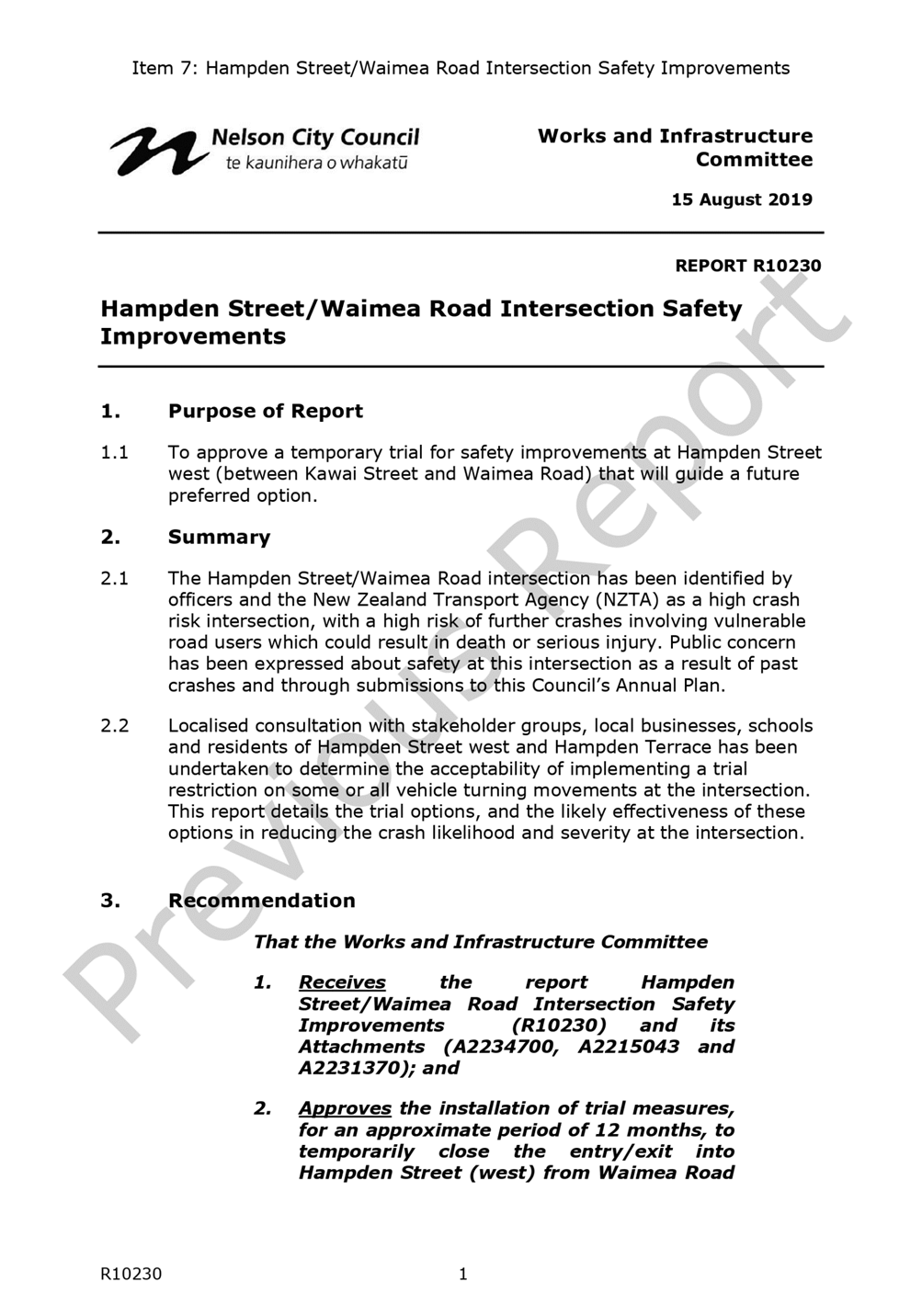
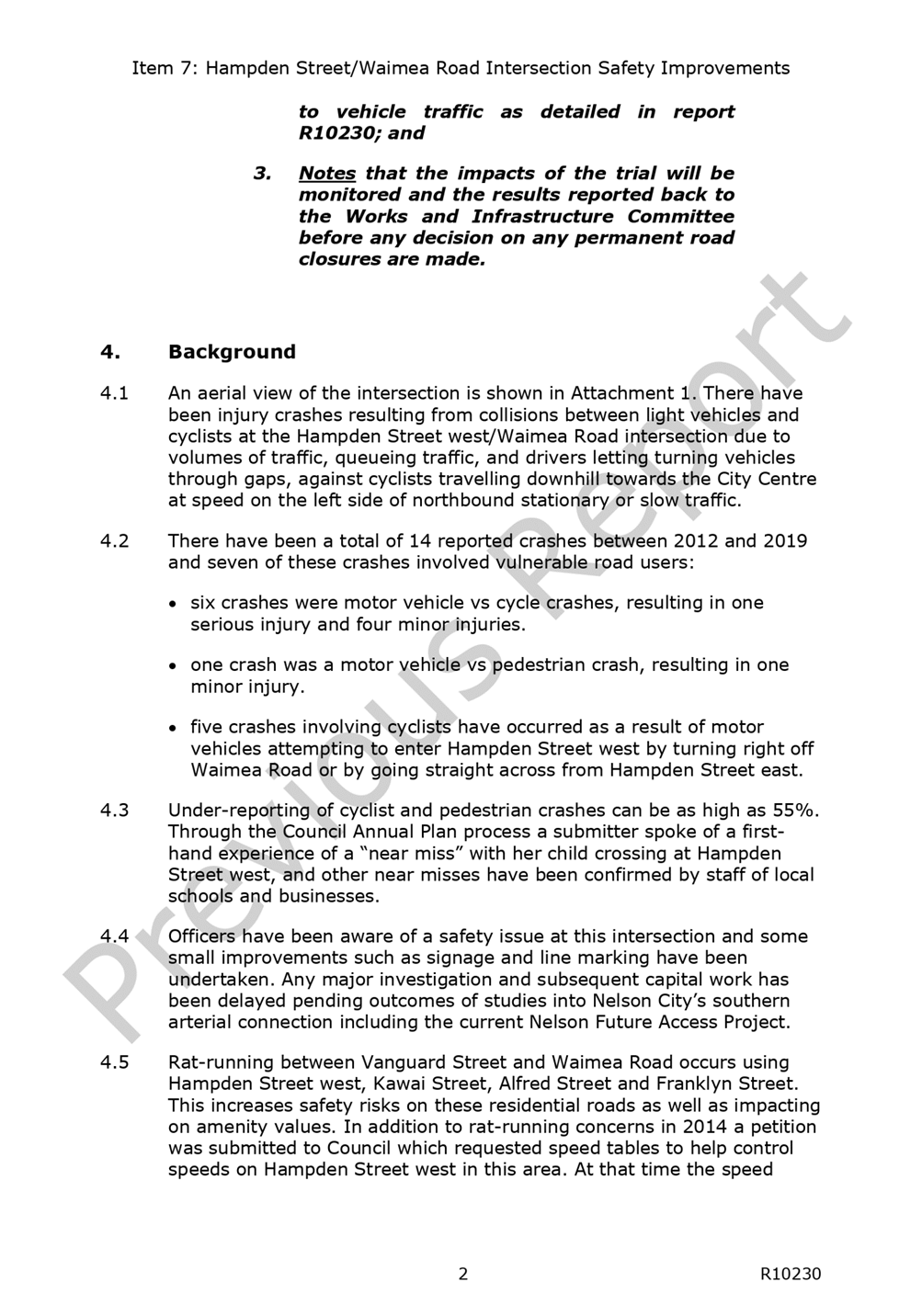
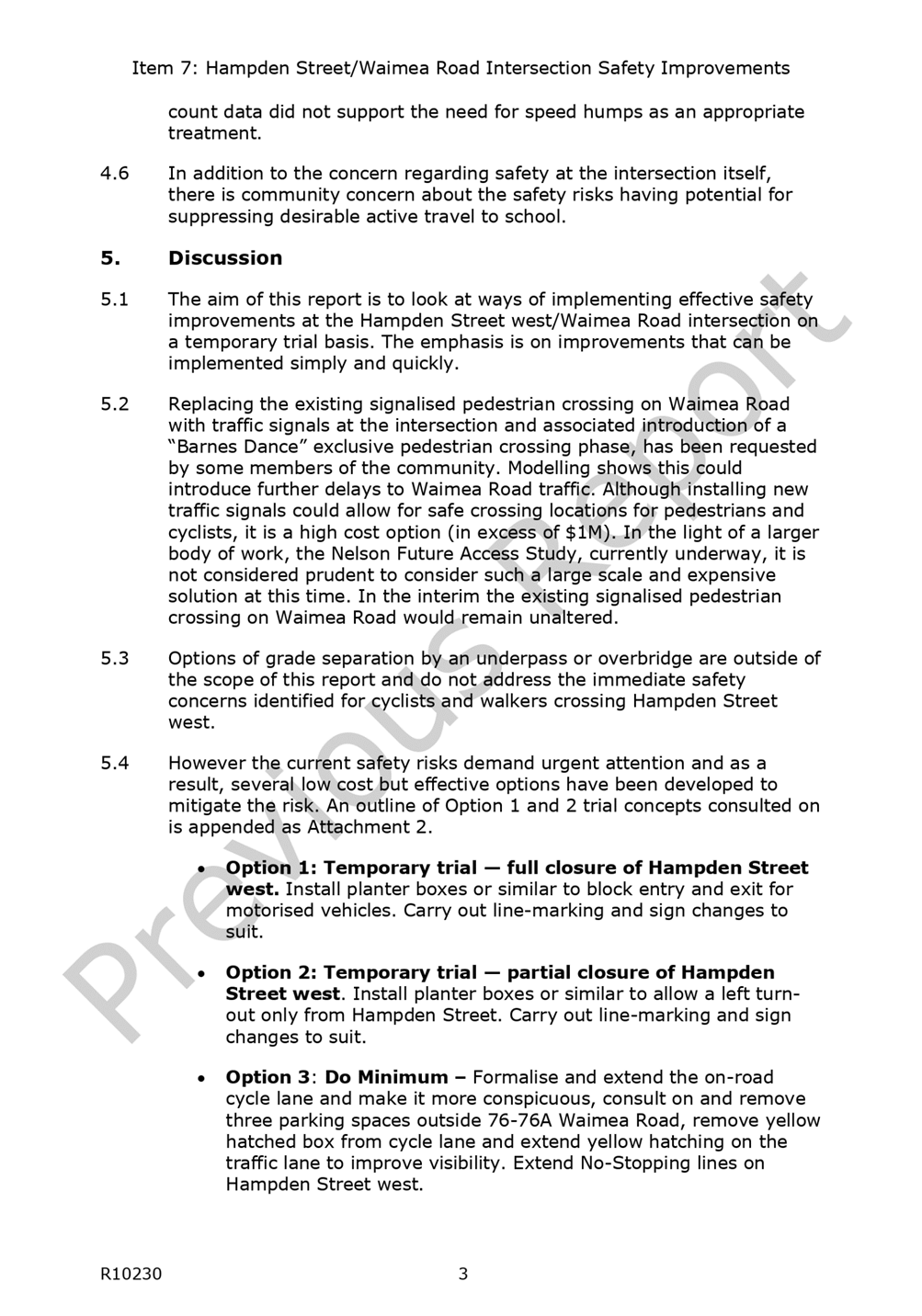
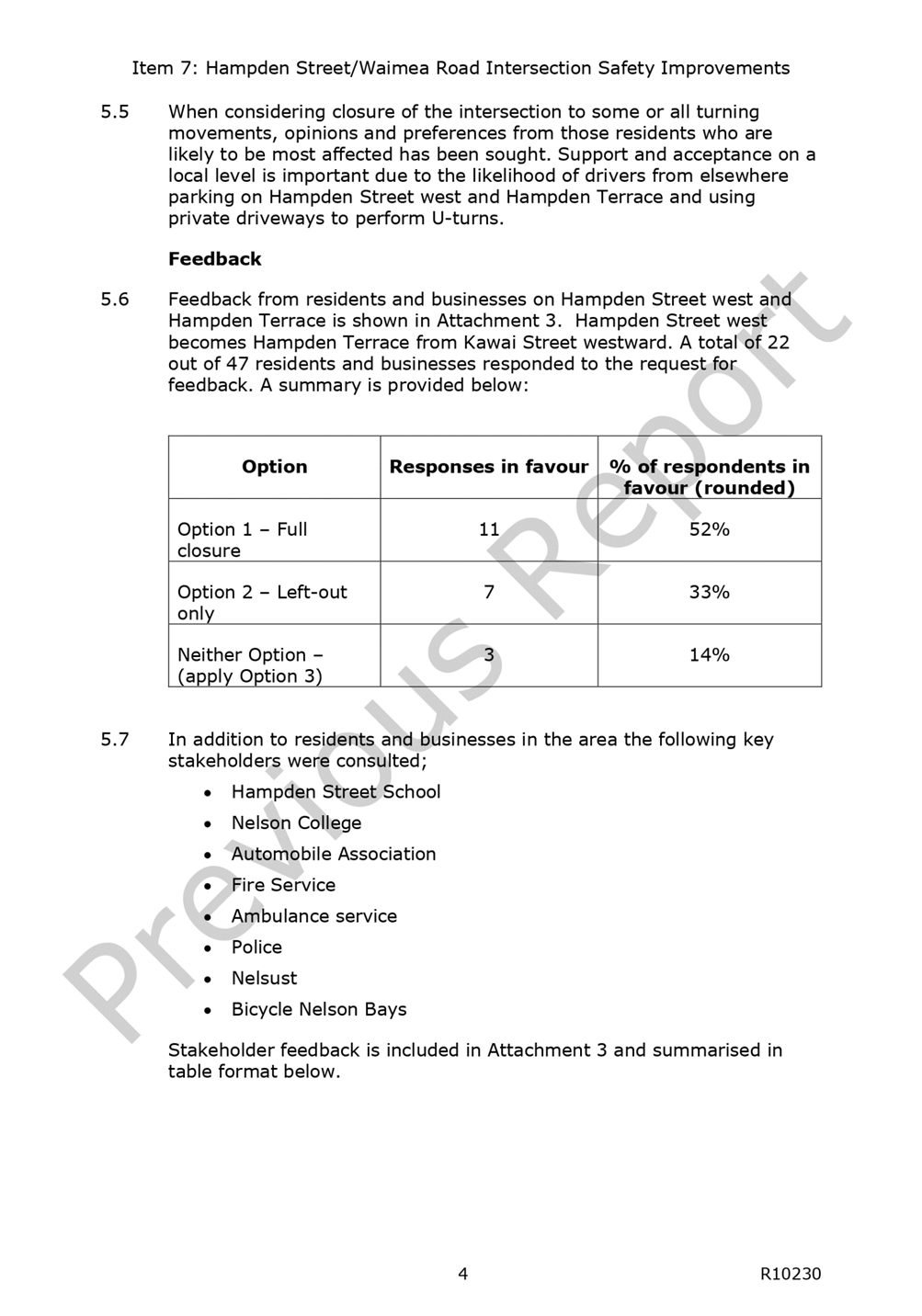
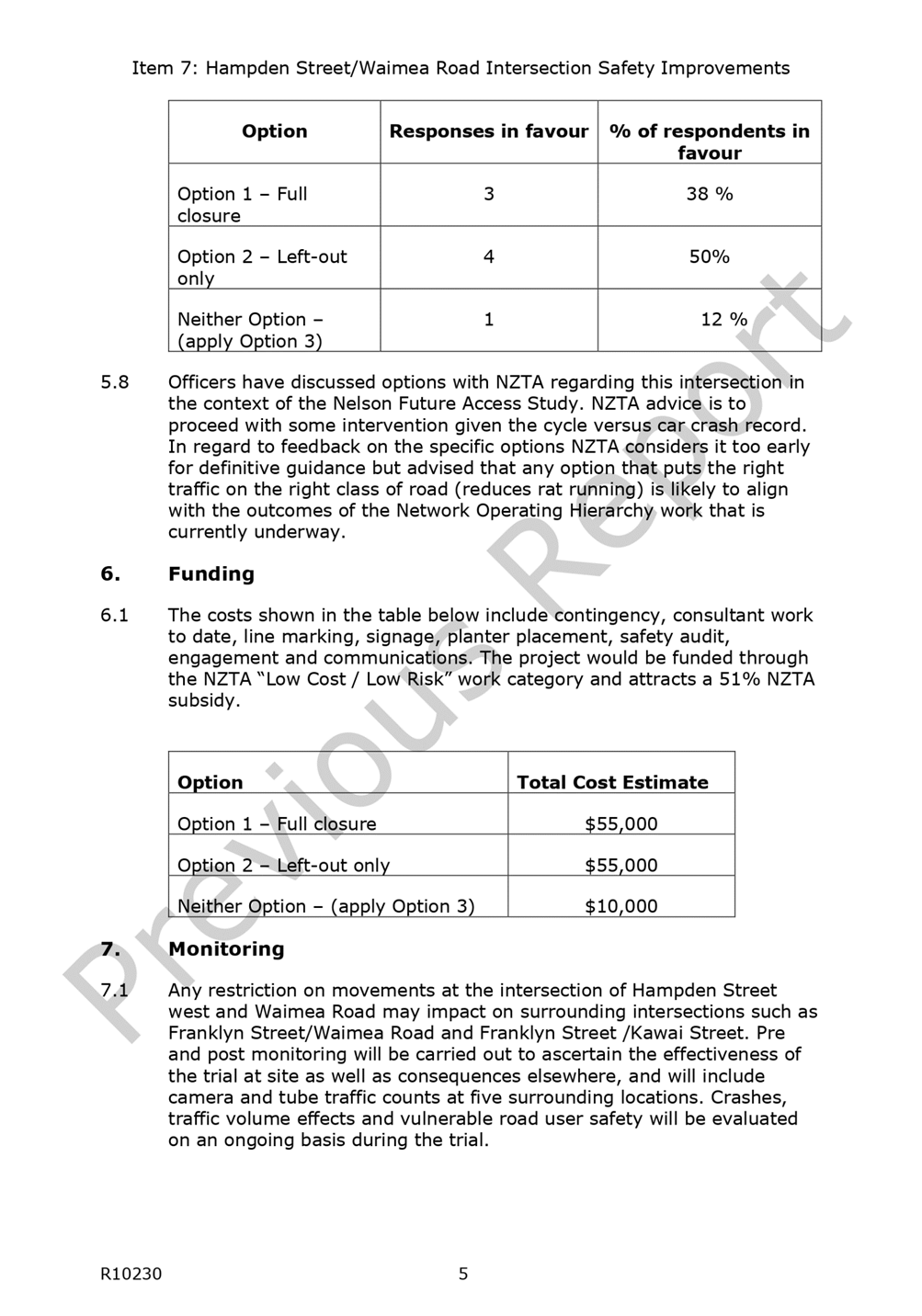
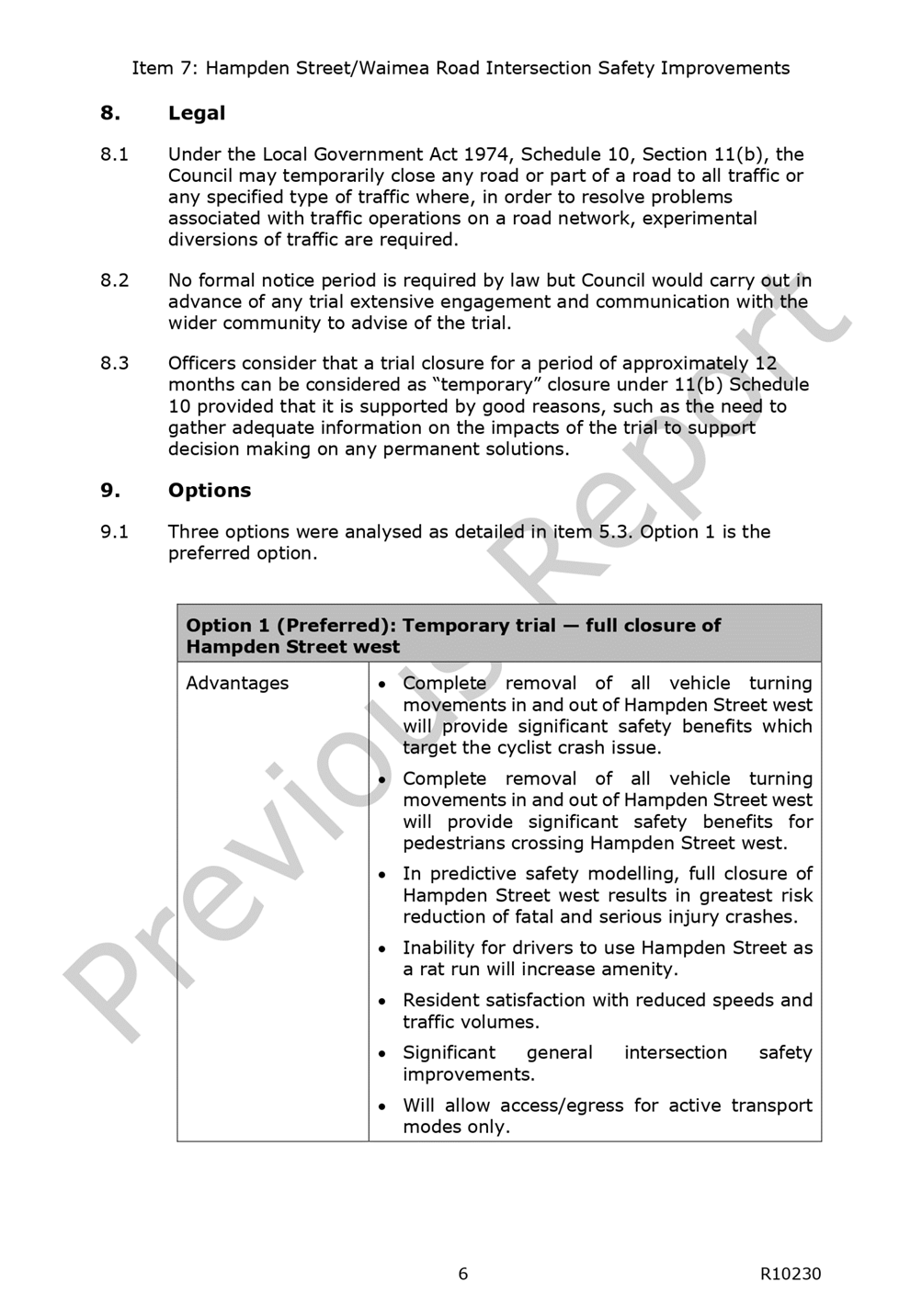
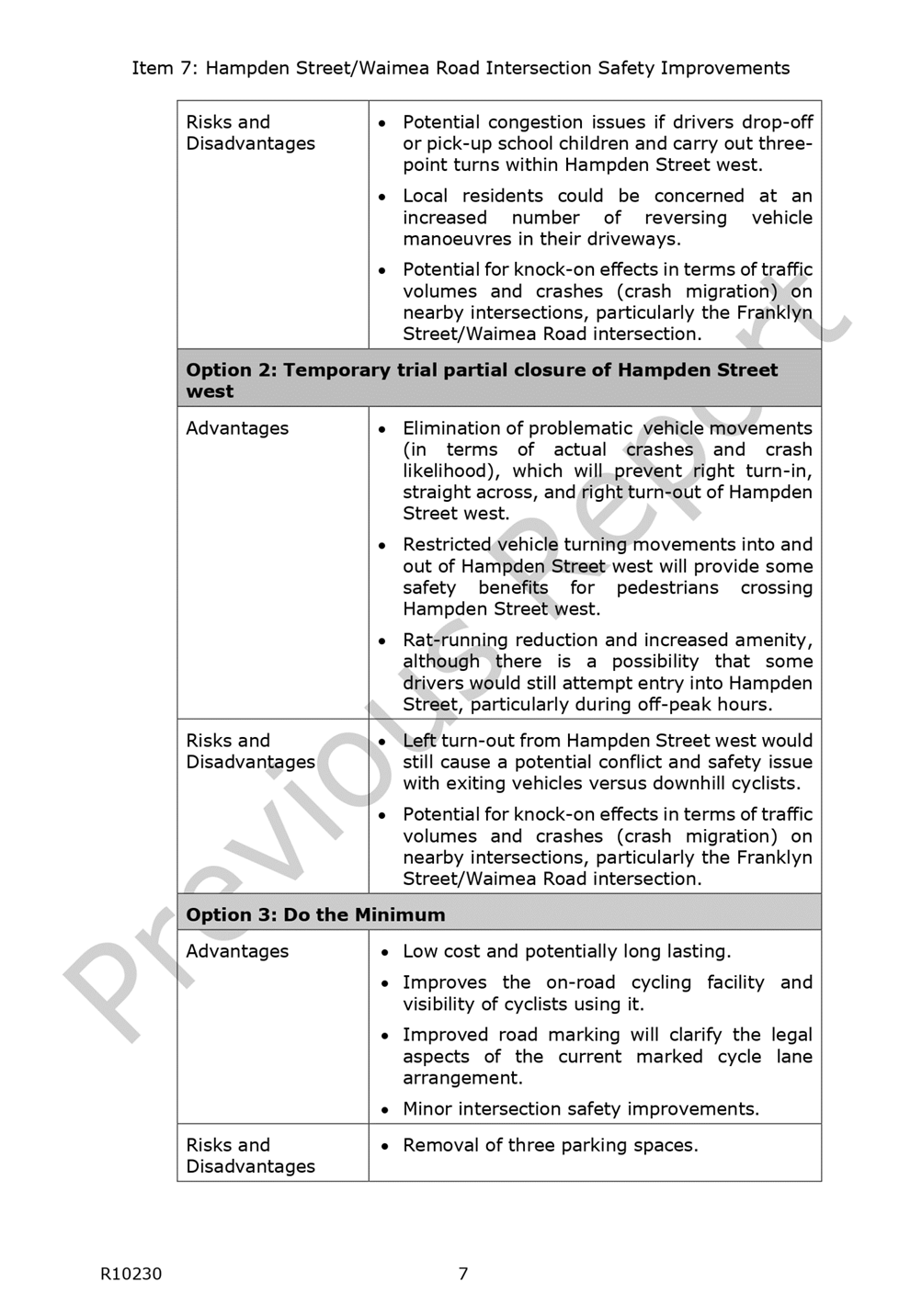
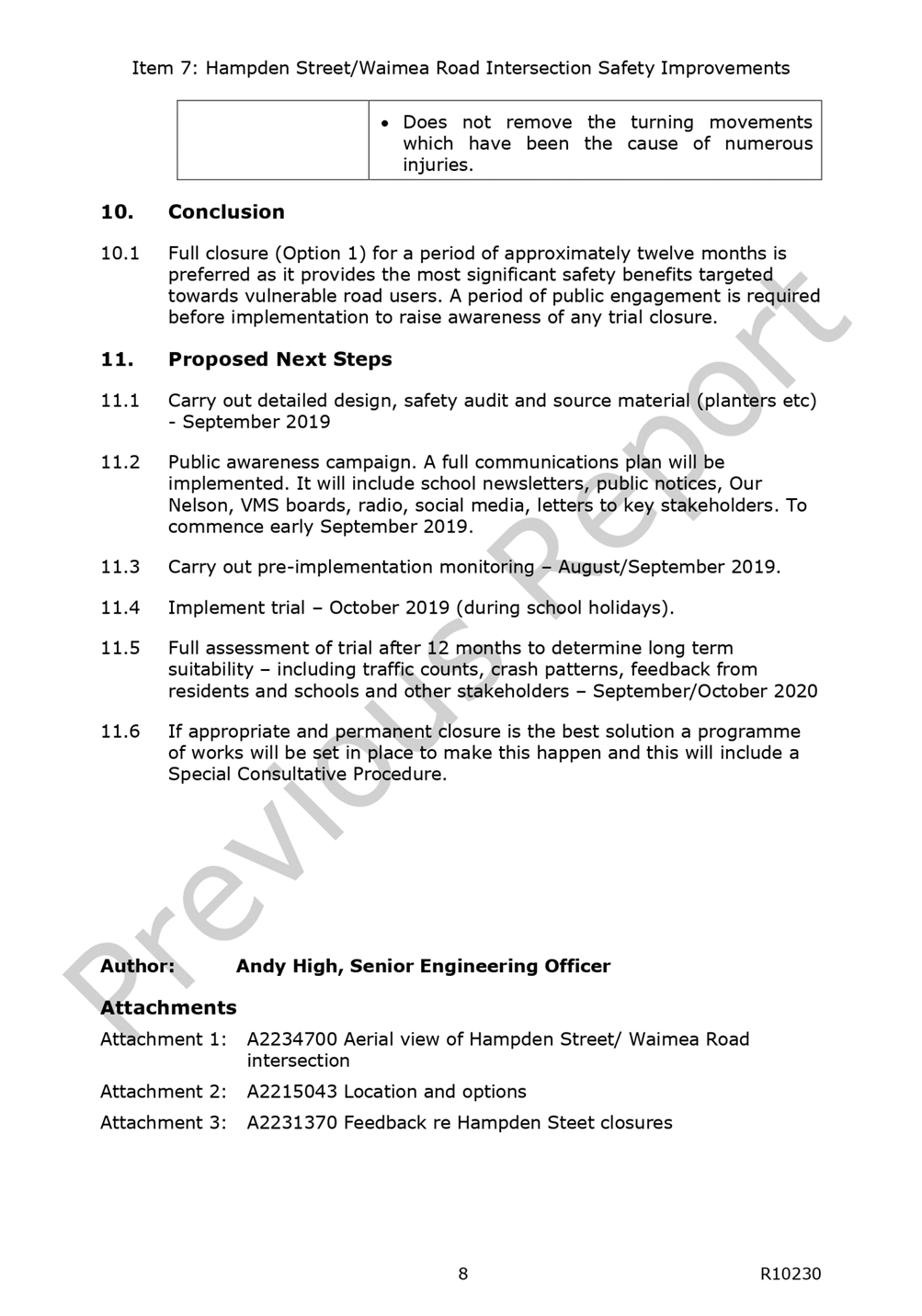
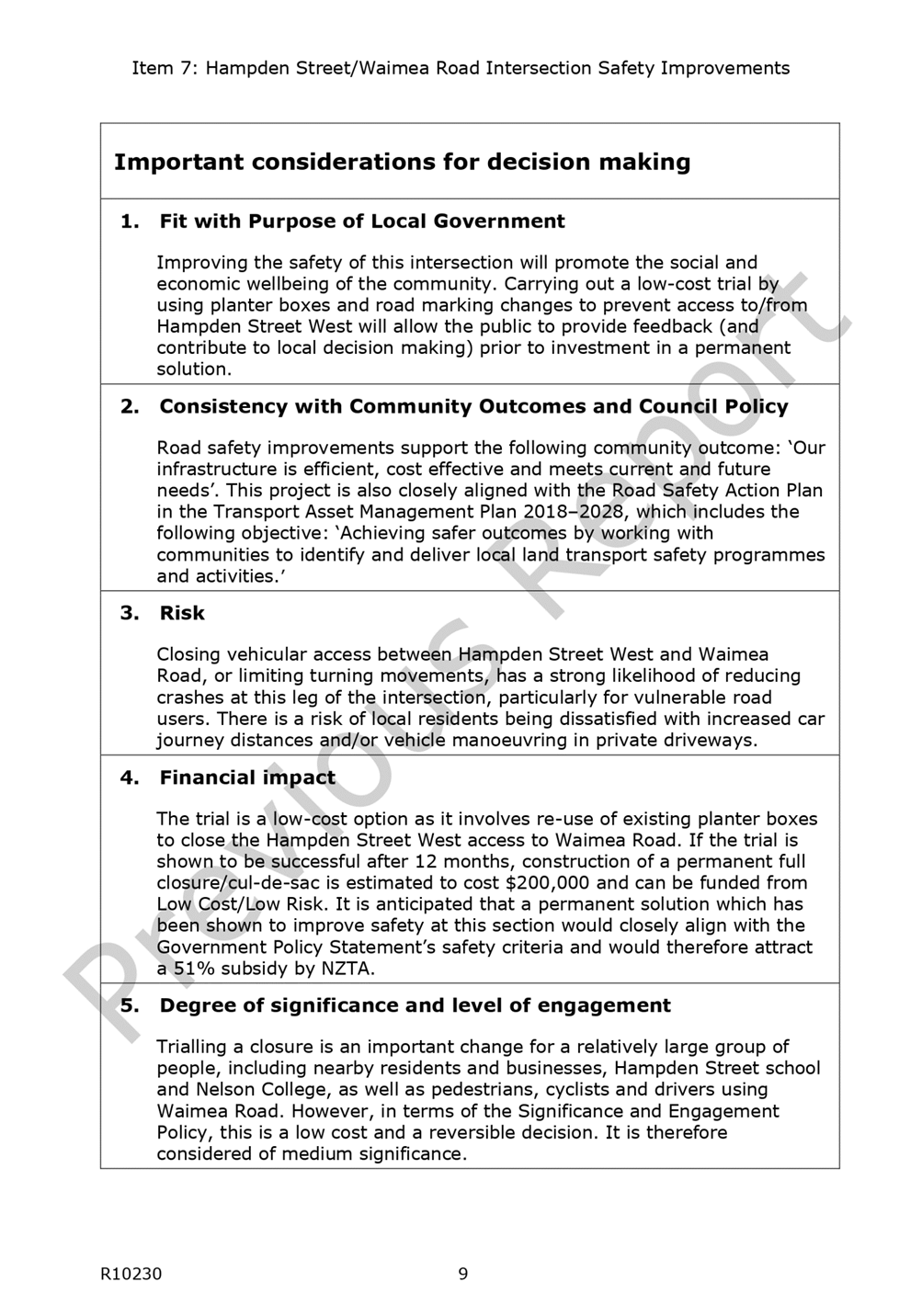
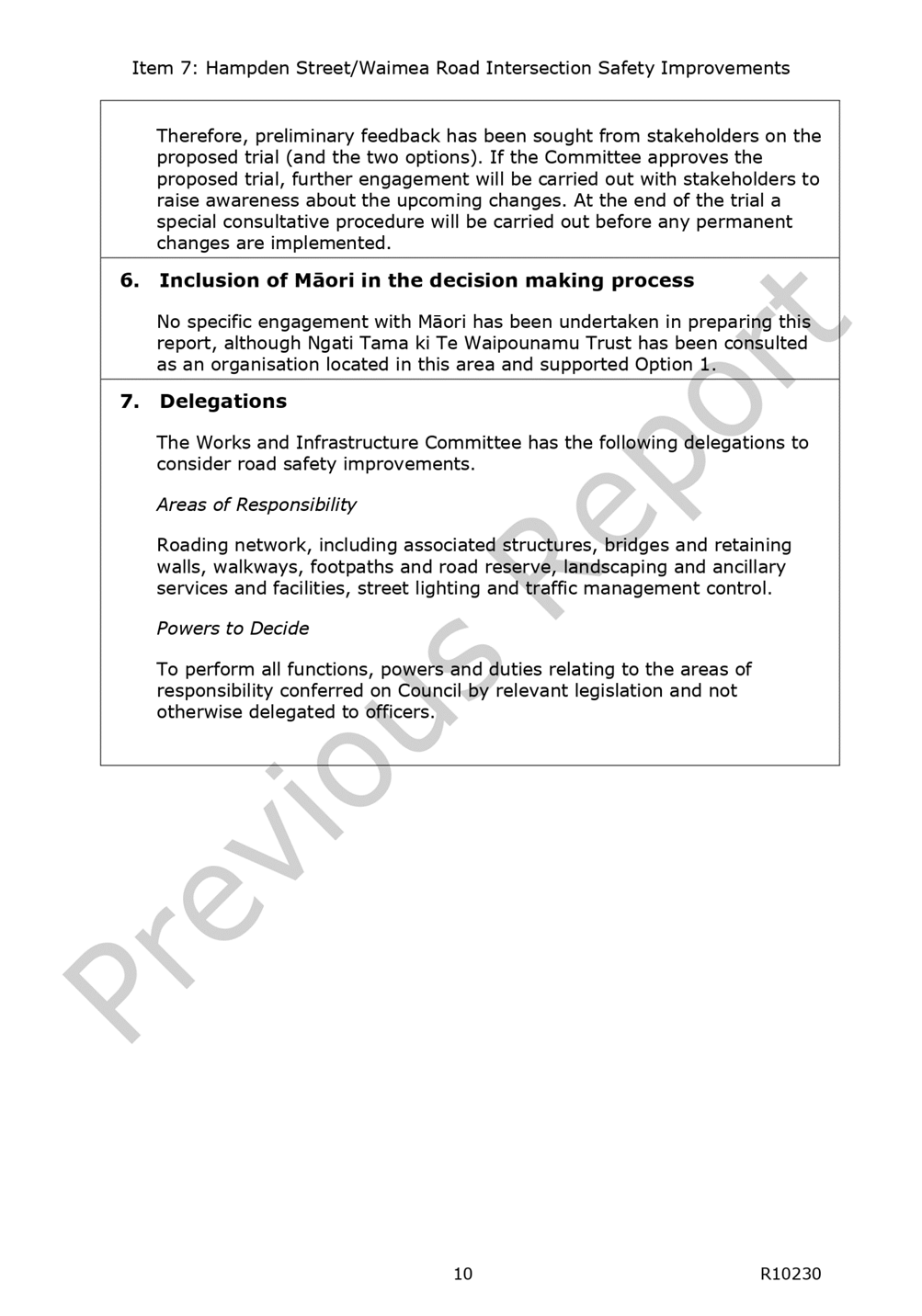





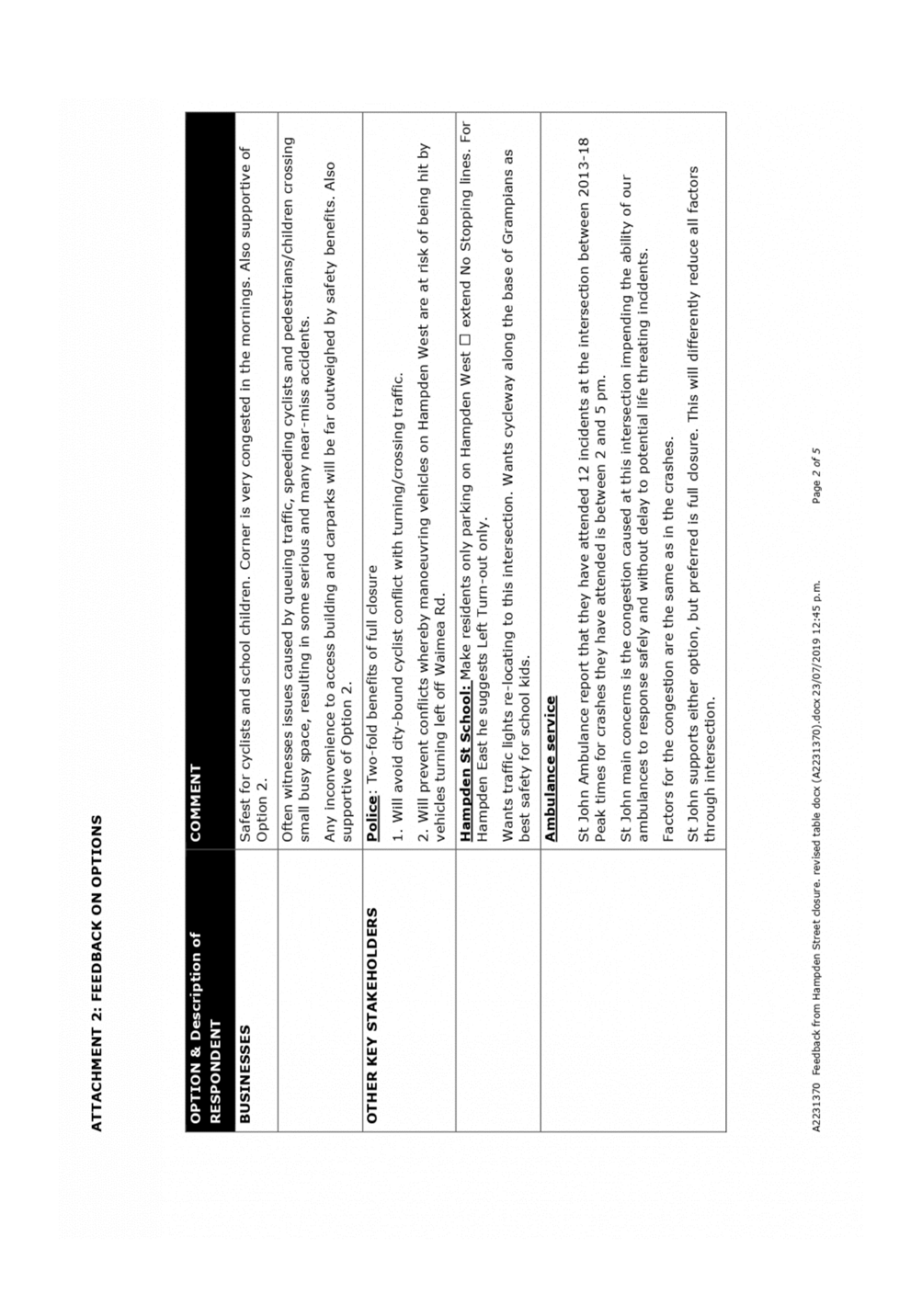

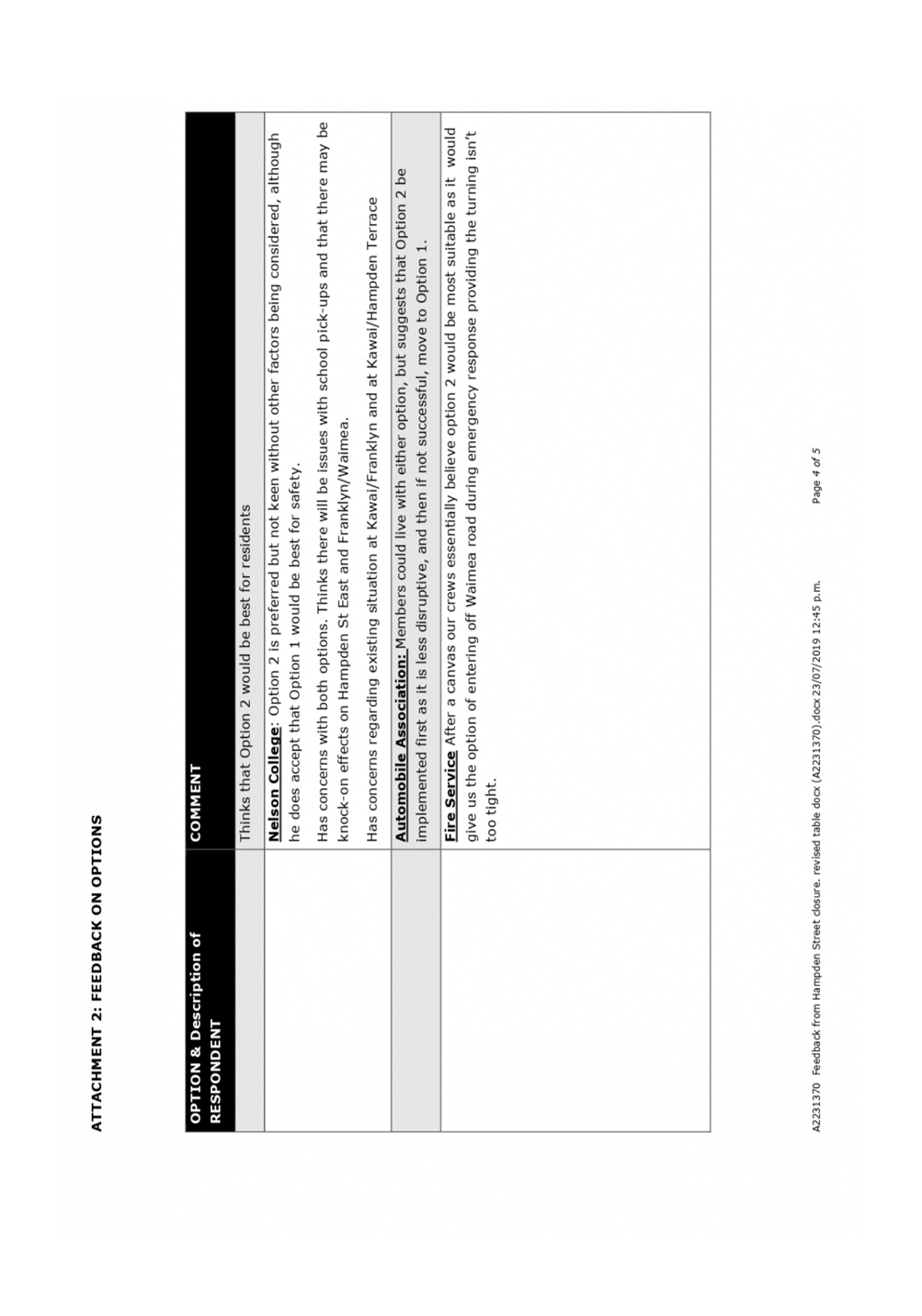

Item 10: Hampden Street
Closure - monitoring results and next steps: Attachment 2
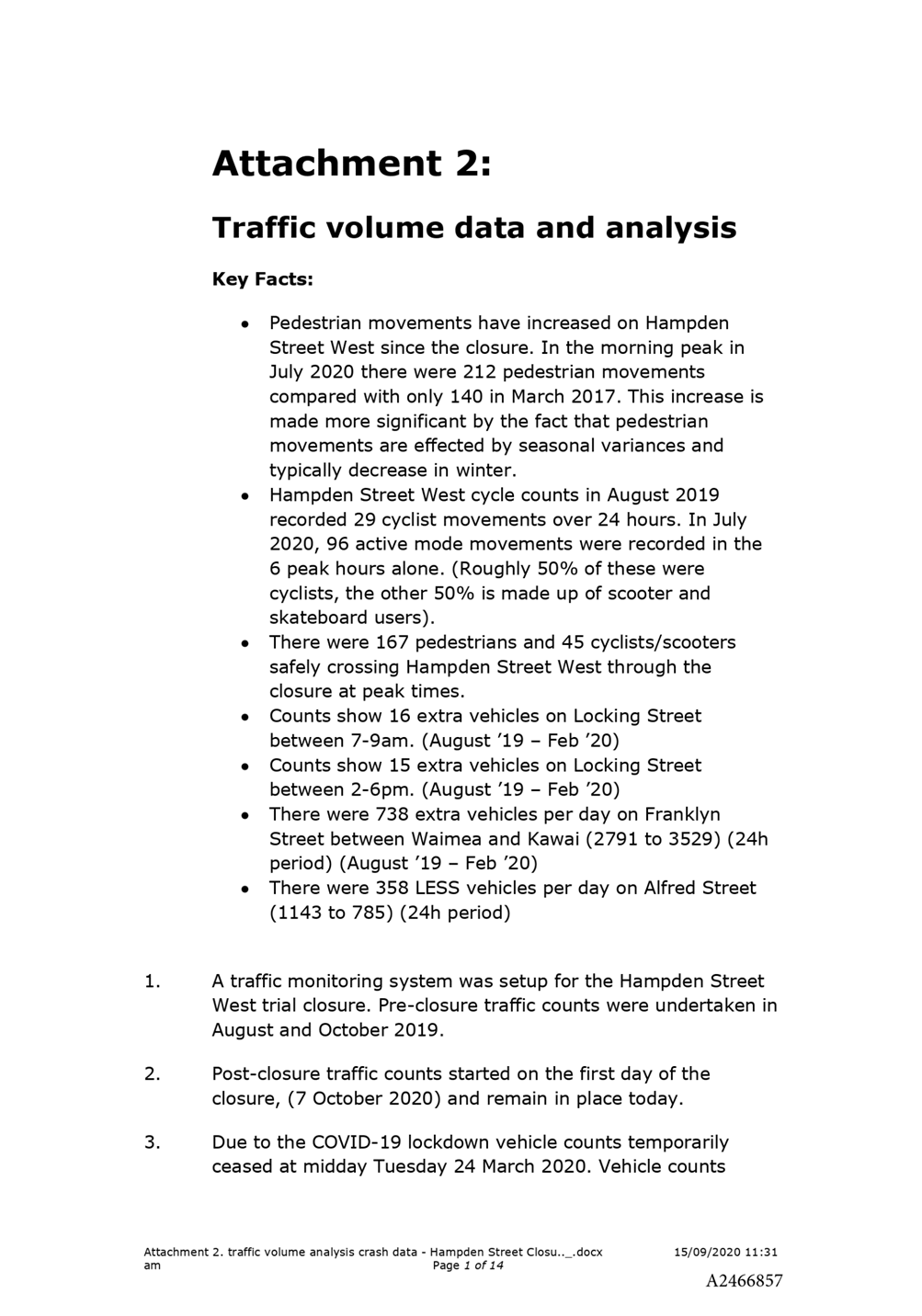
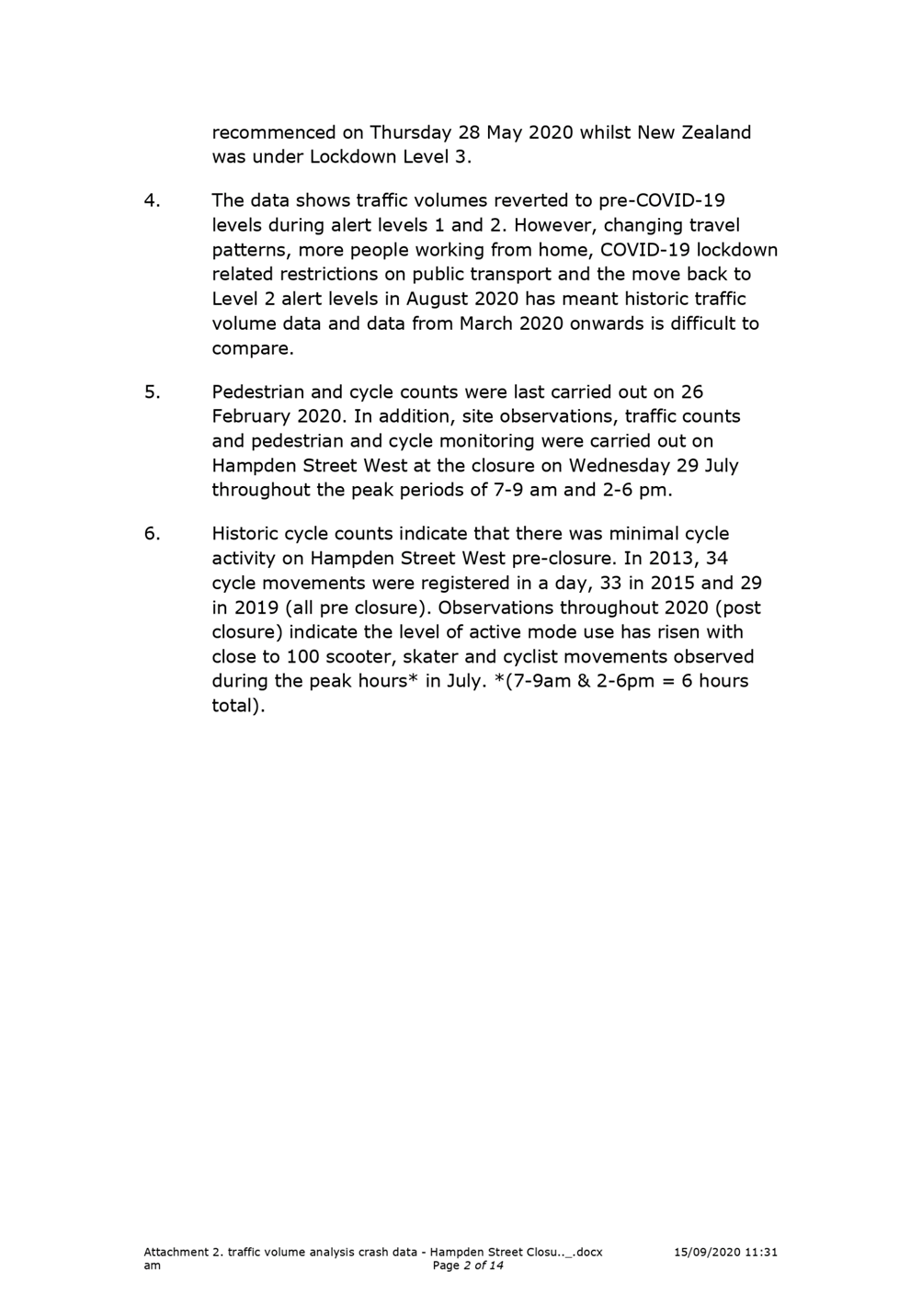

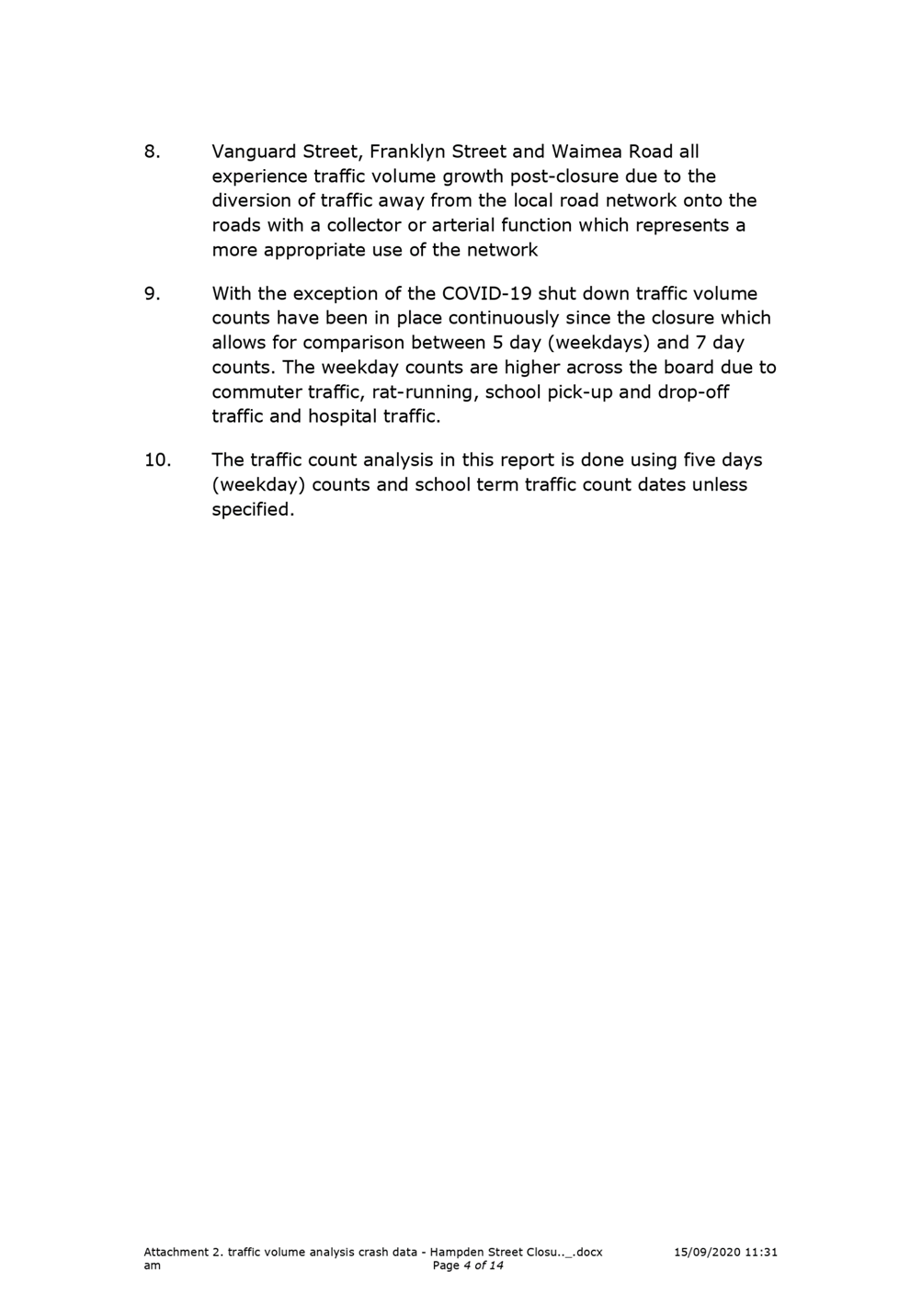
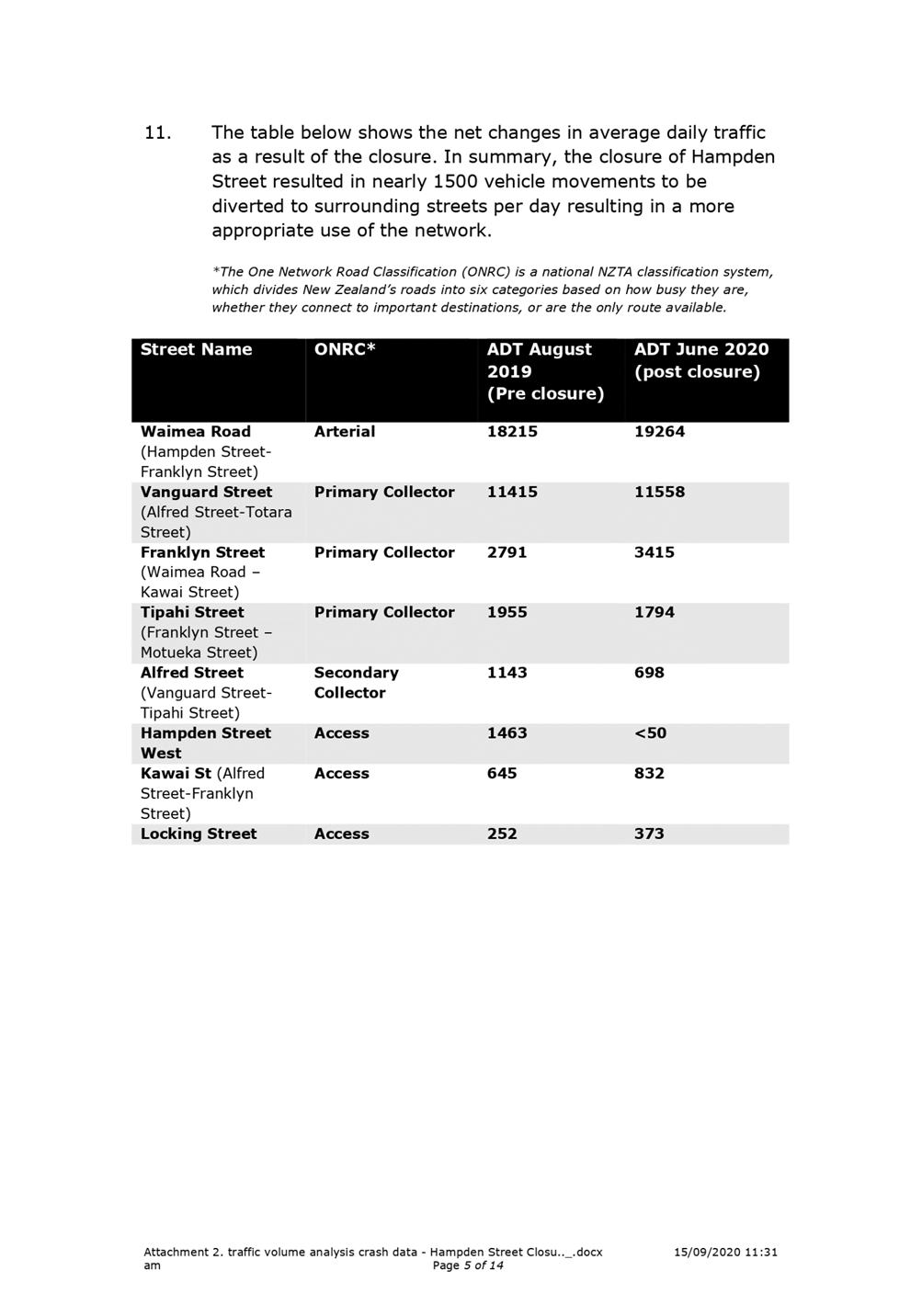

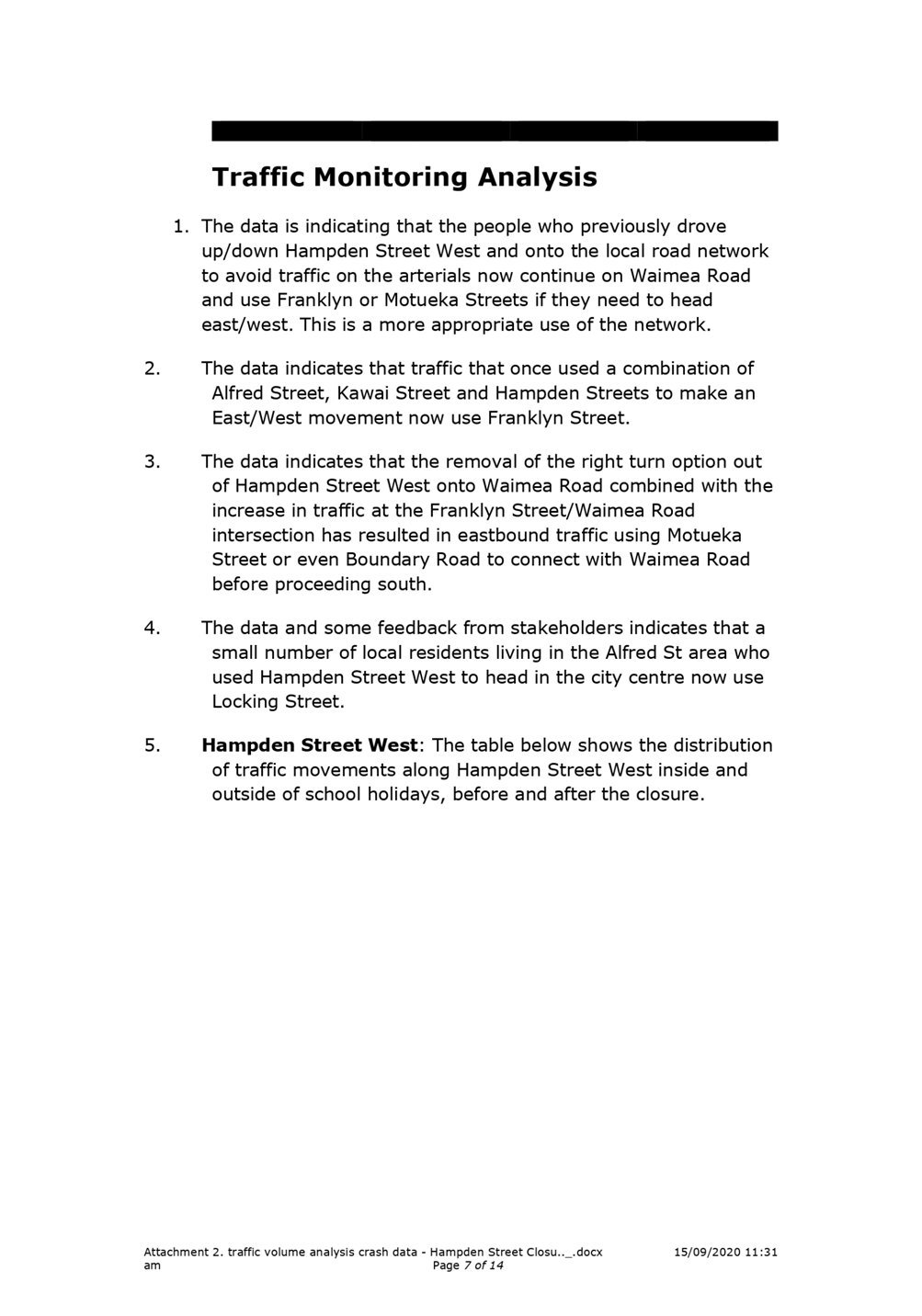













Item 10: Hampden Street Closure - monitoring results and next steps:
Attachment 3










































































































